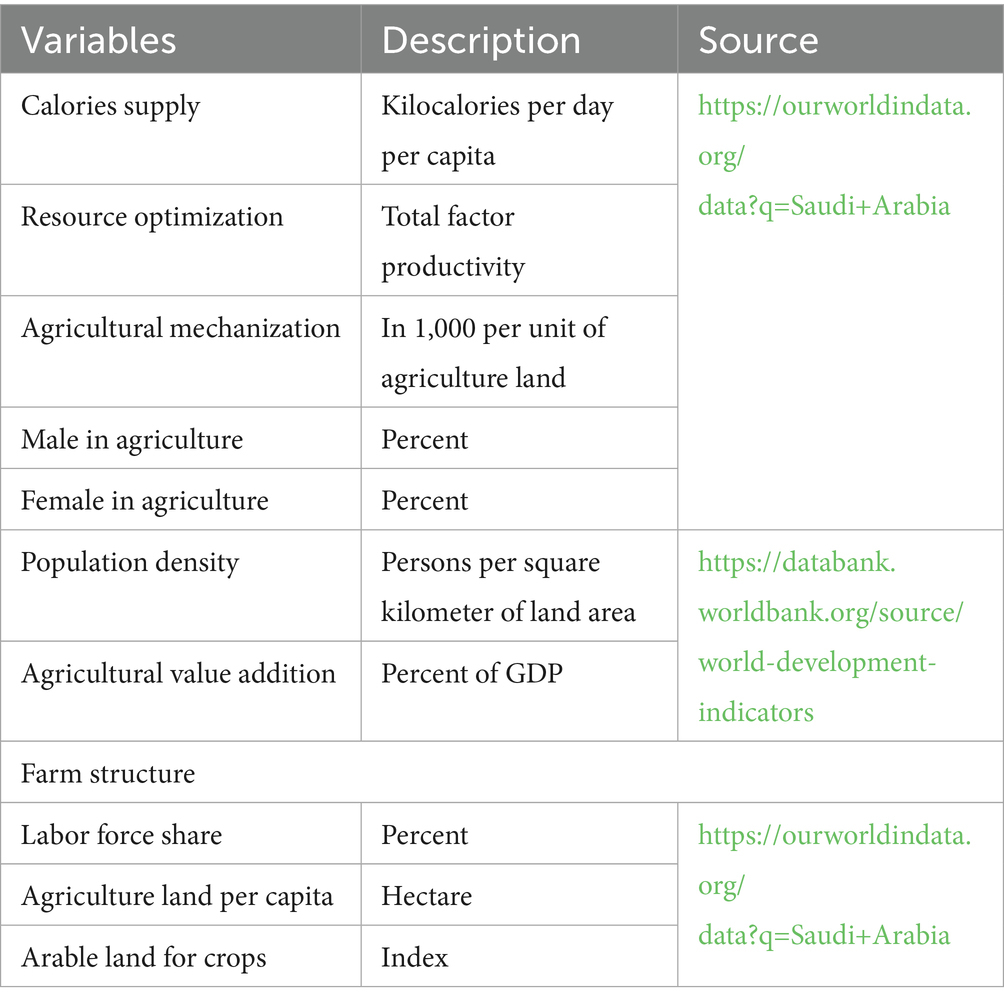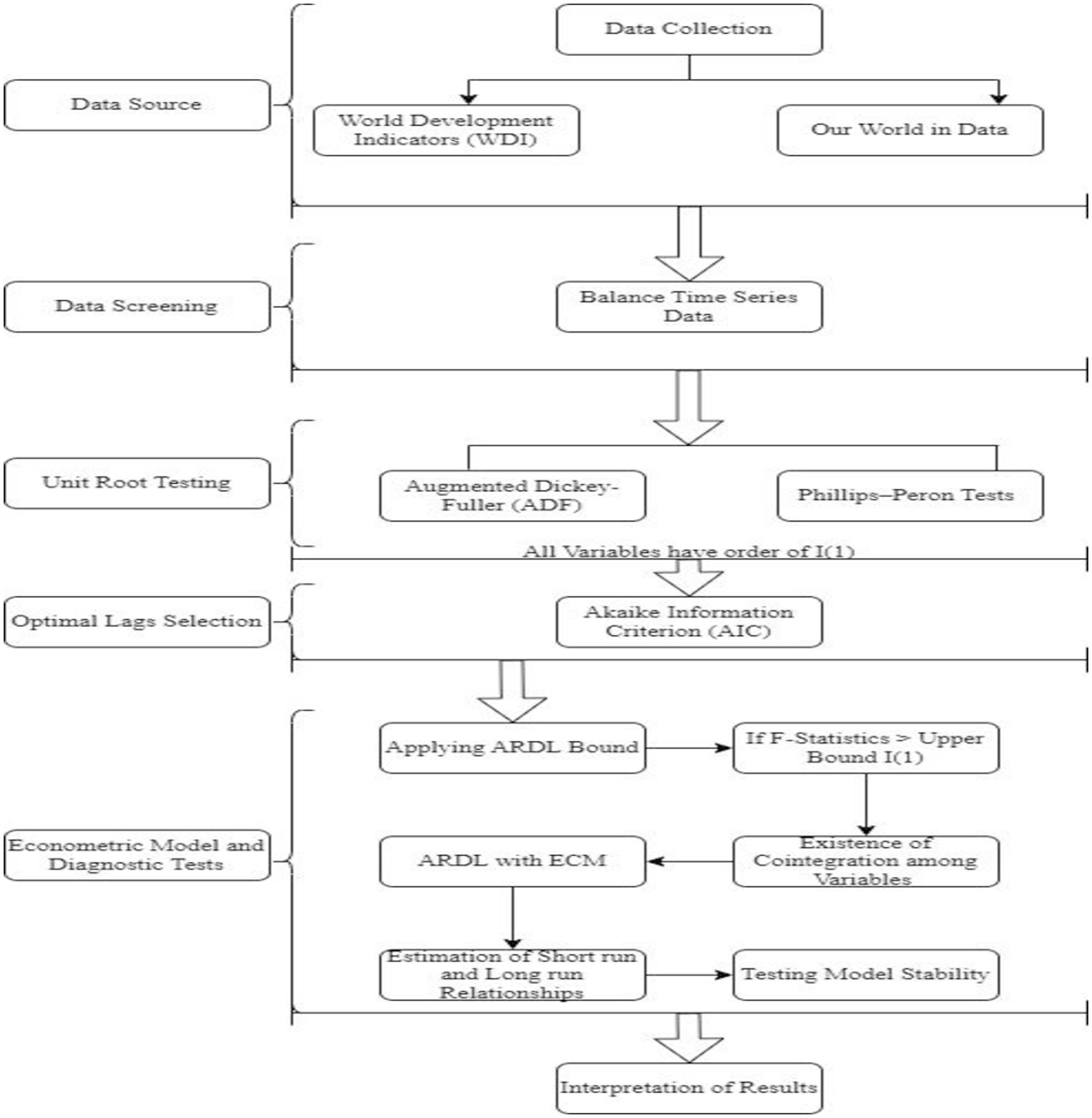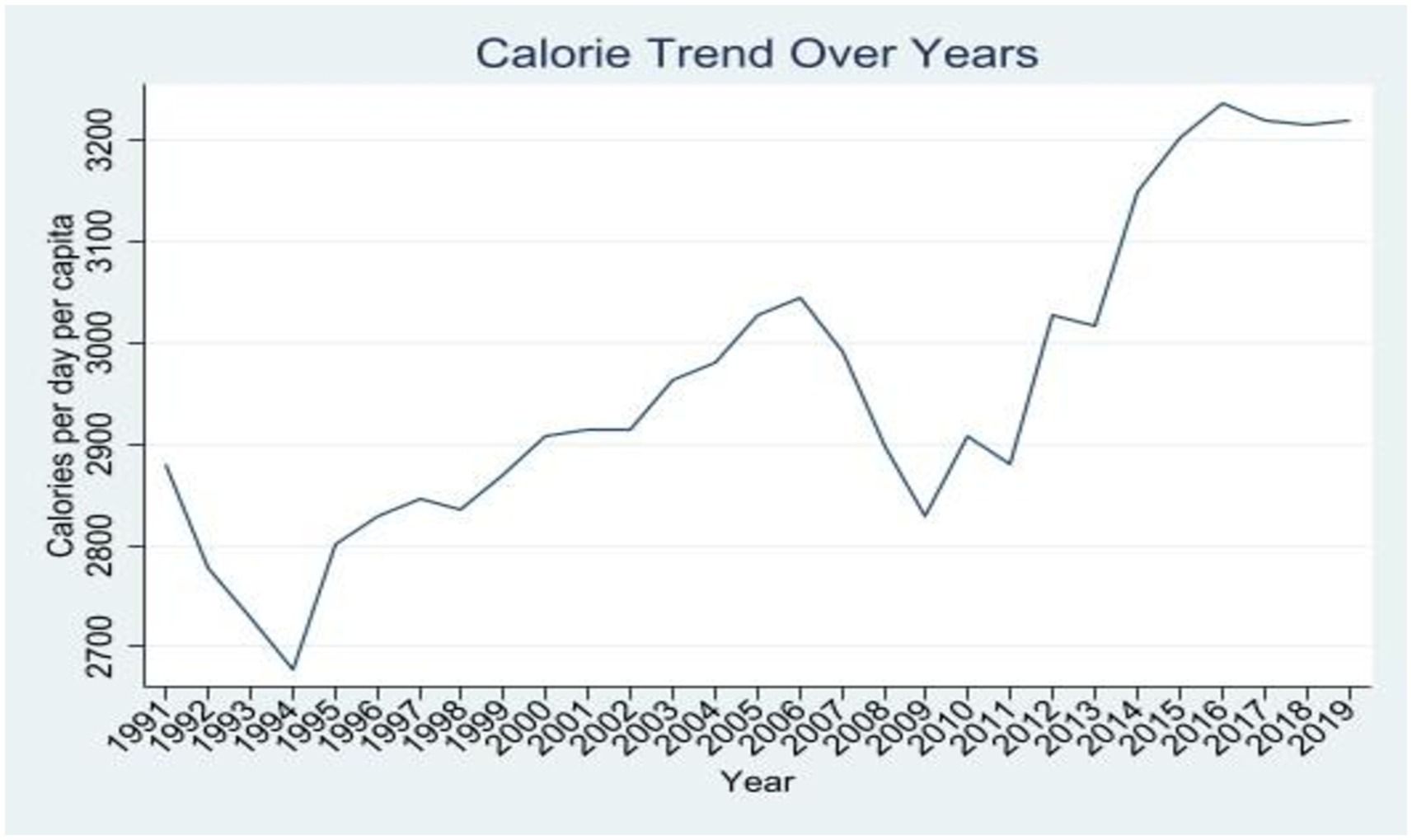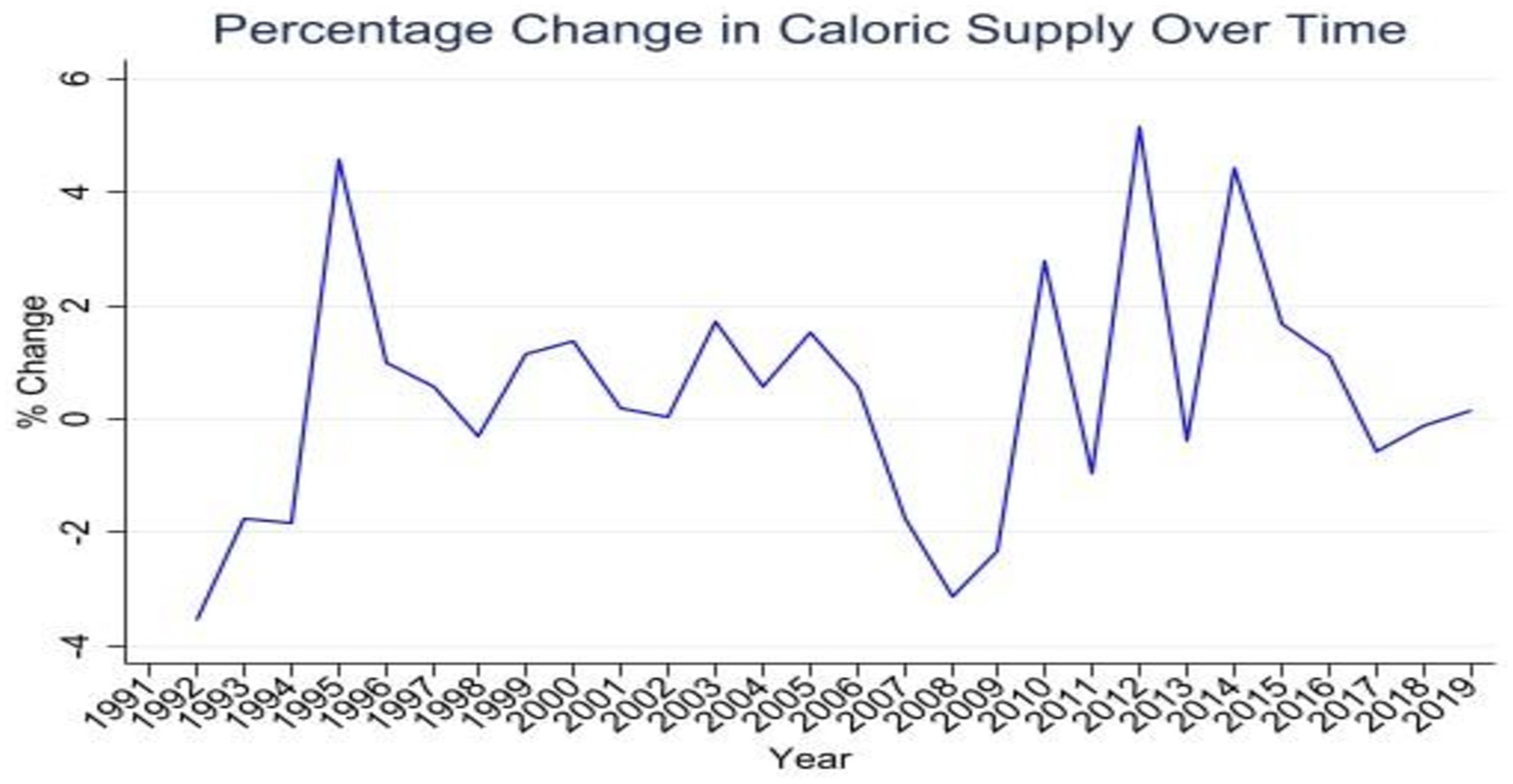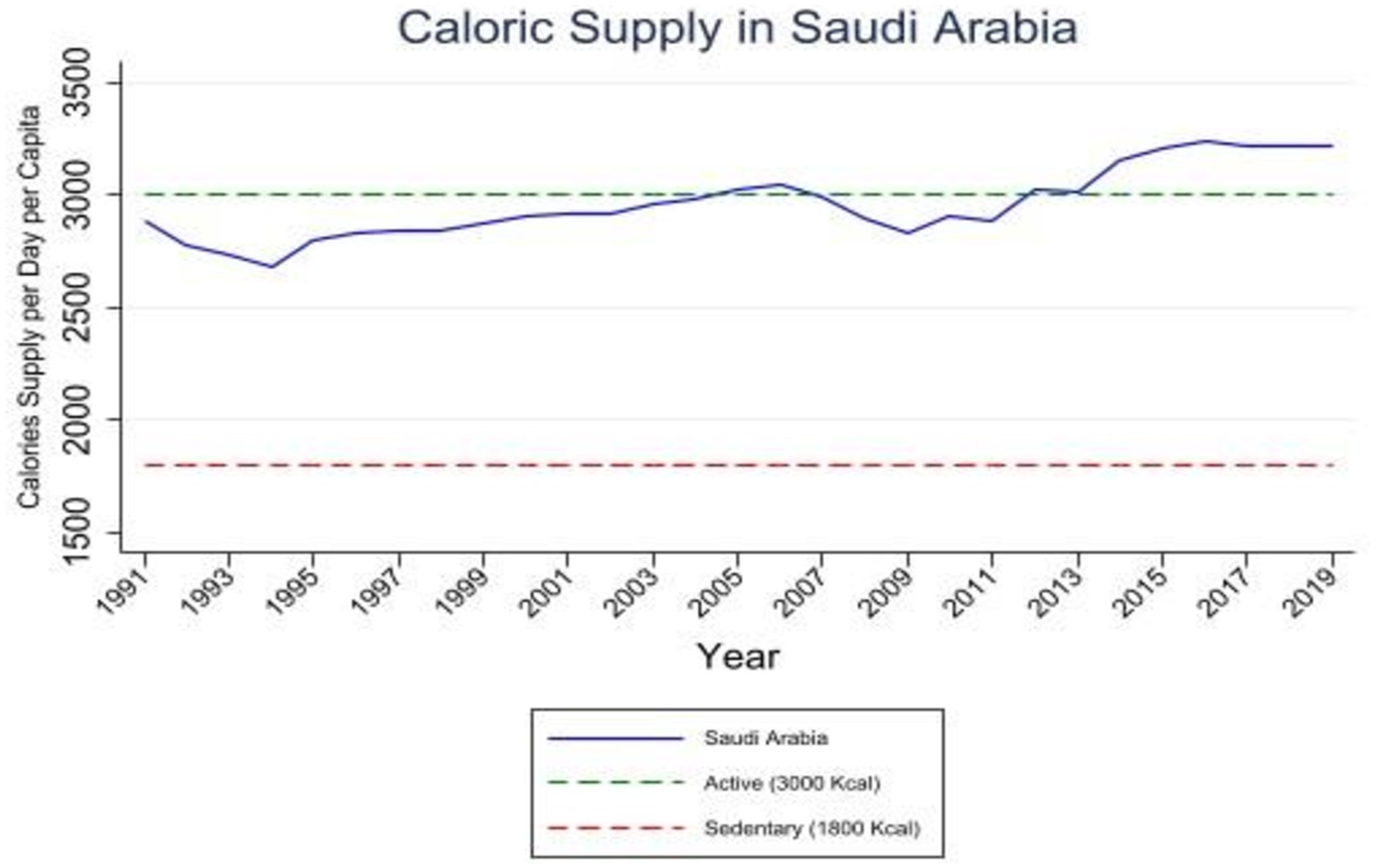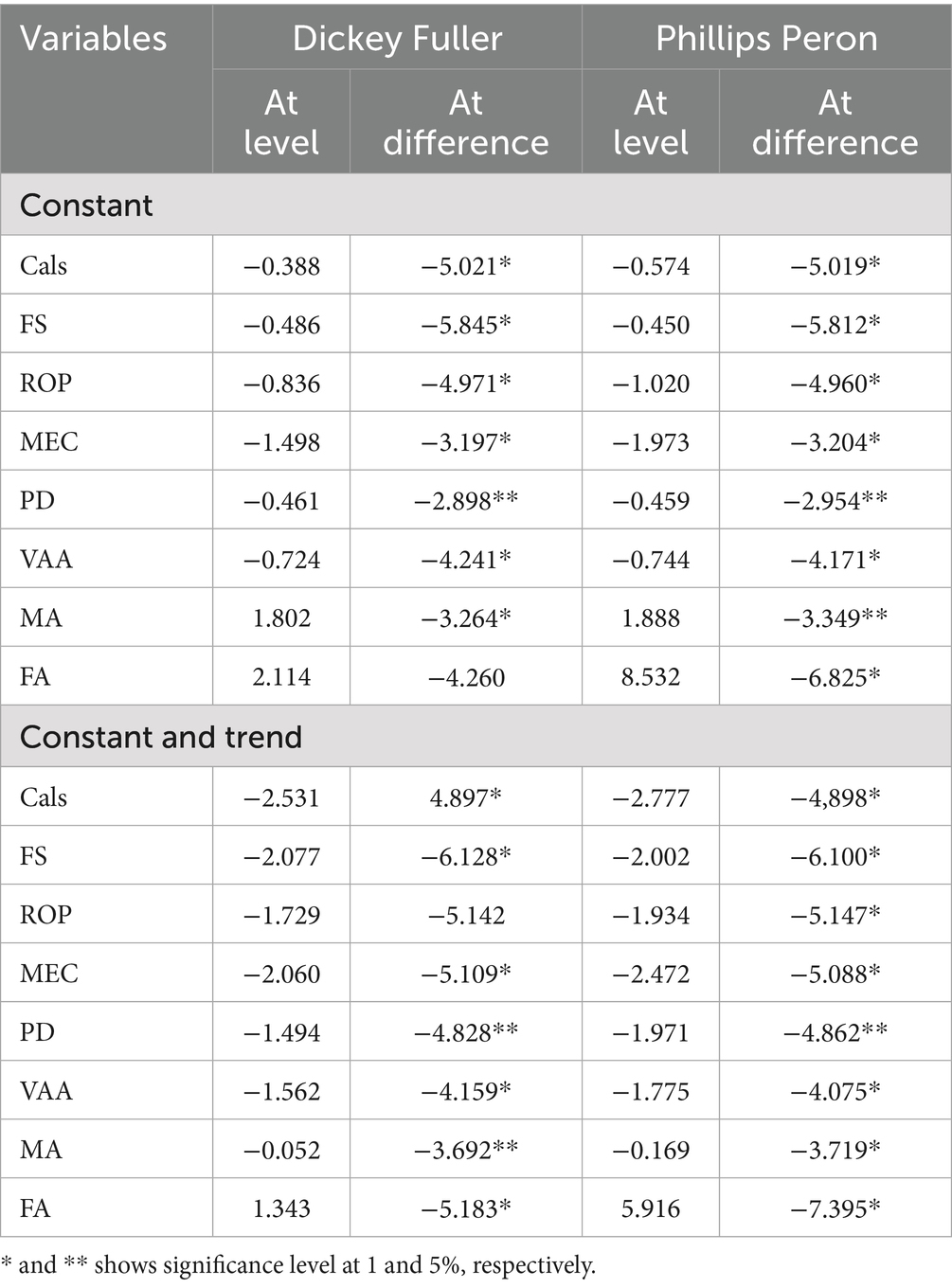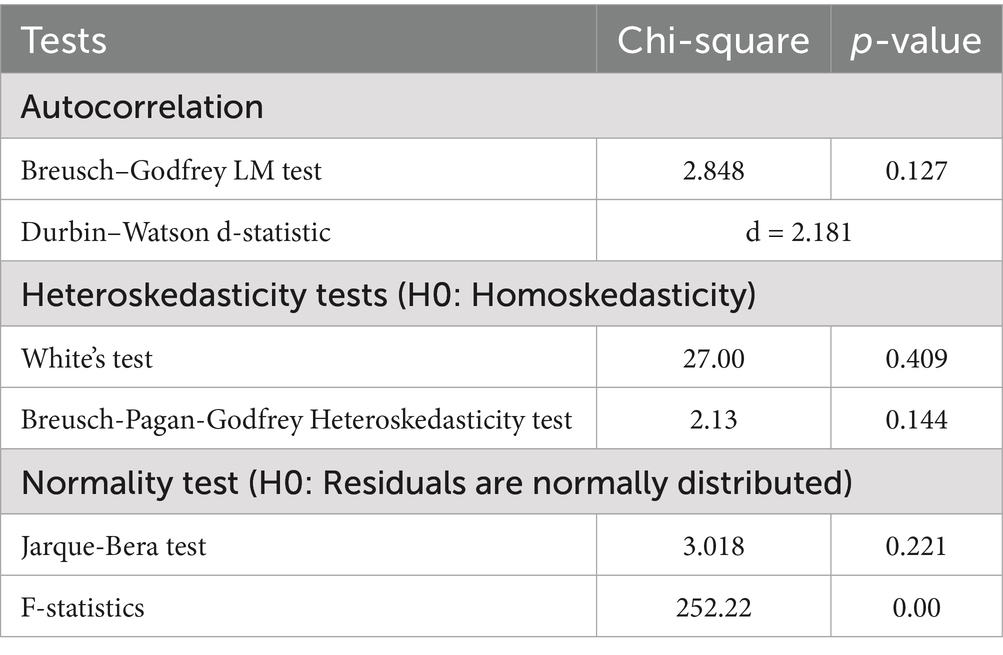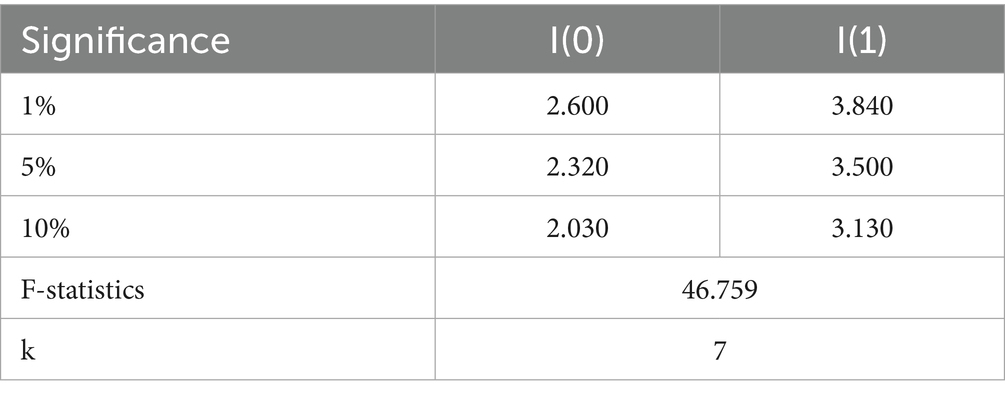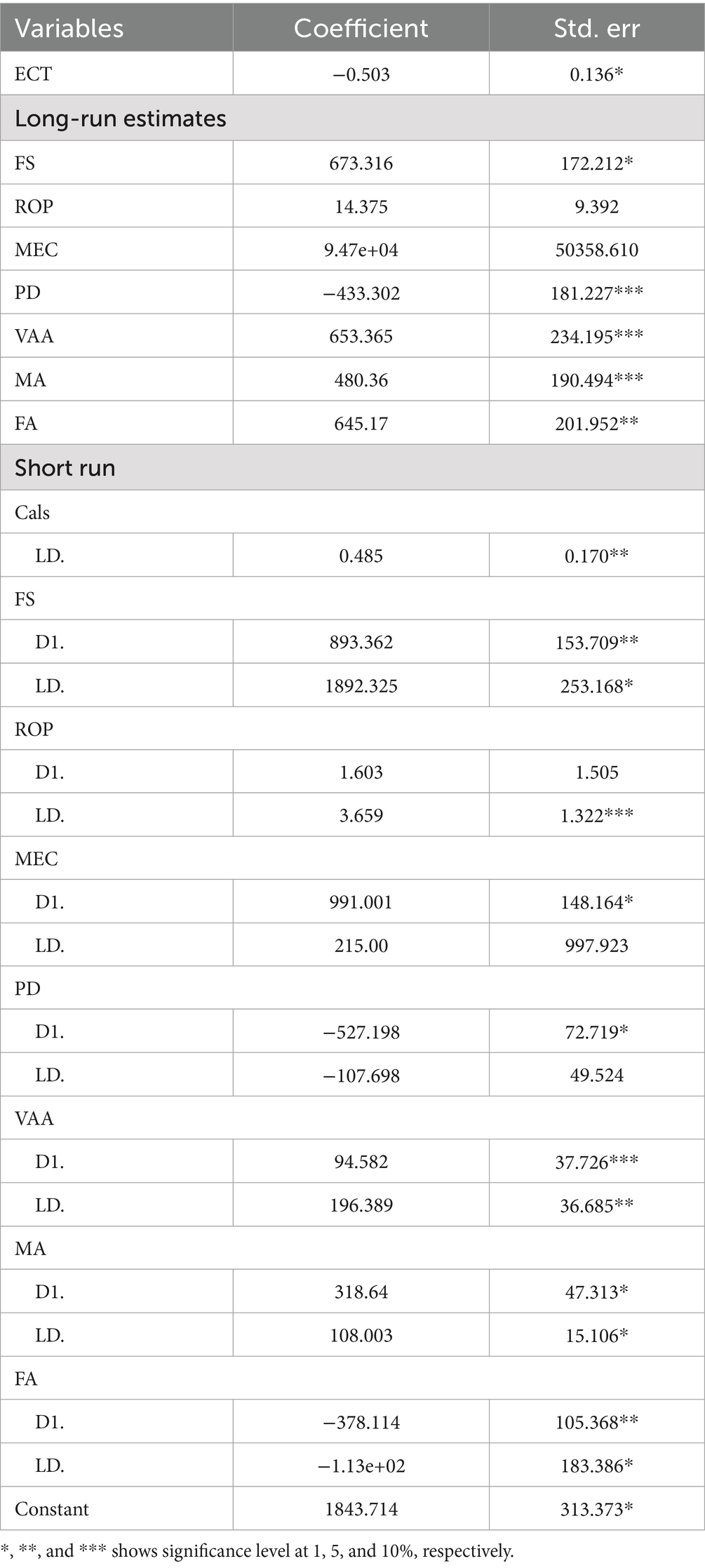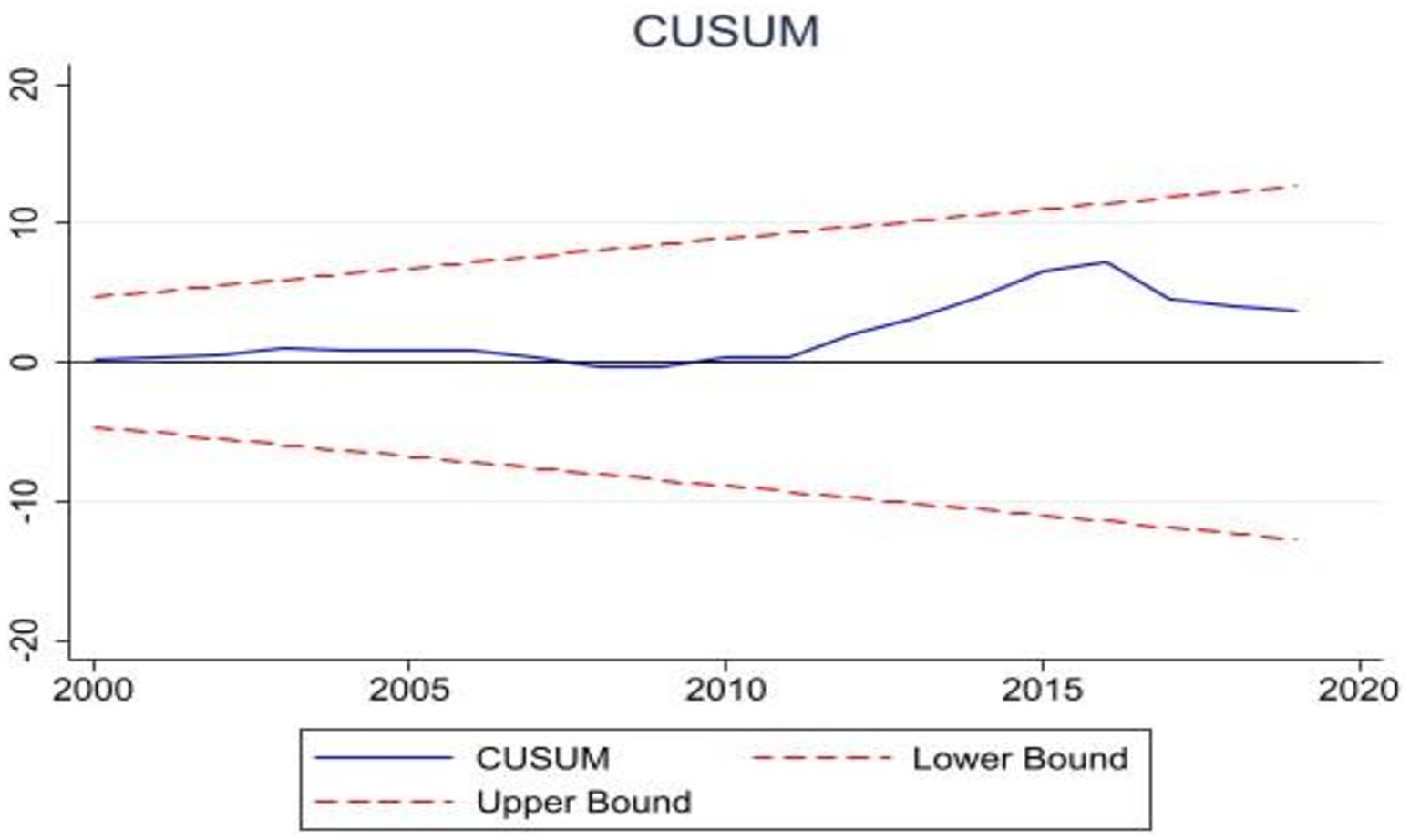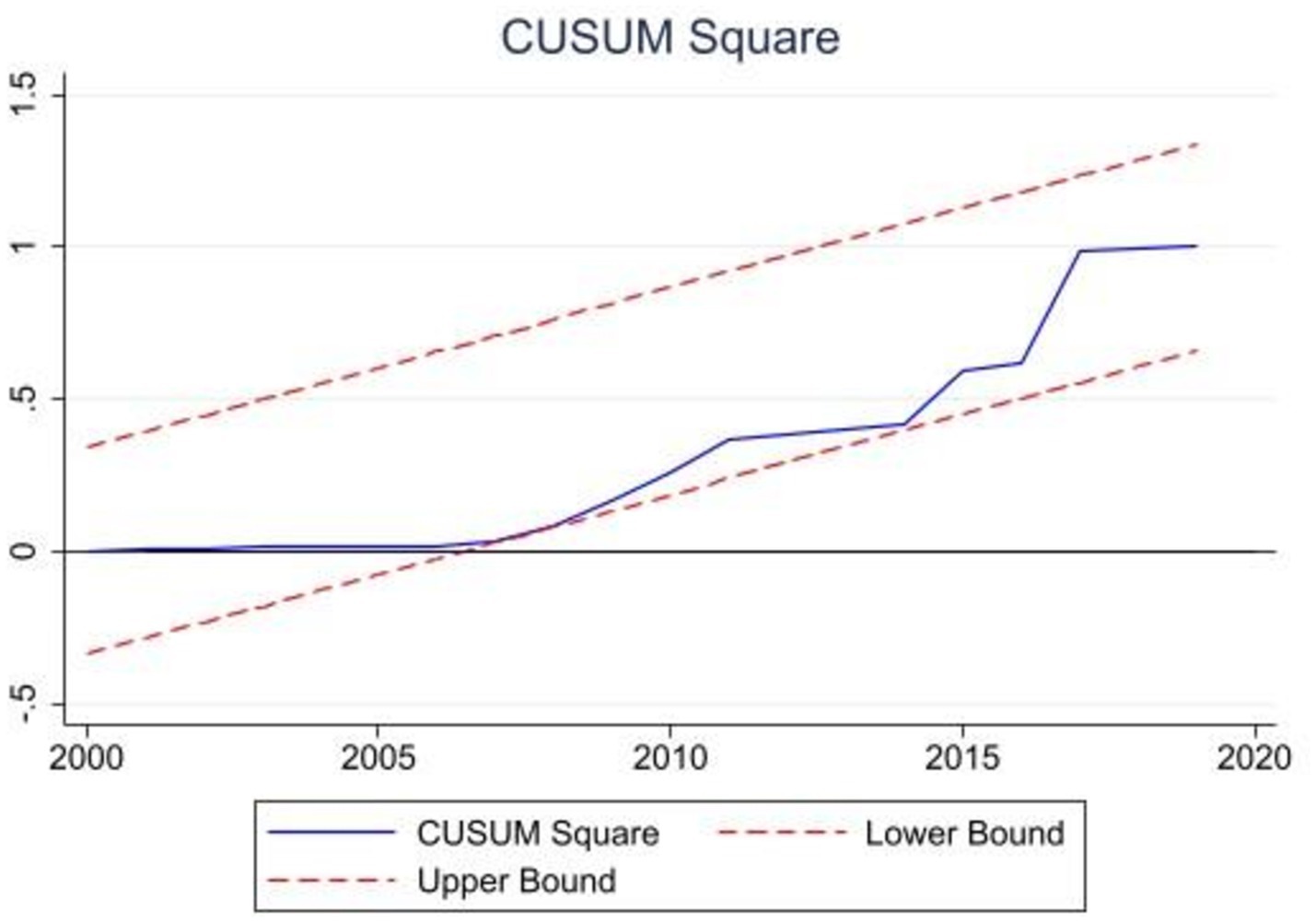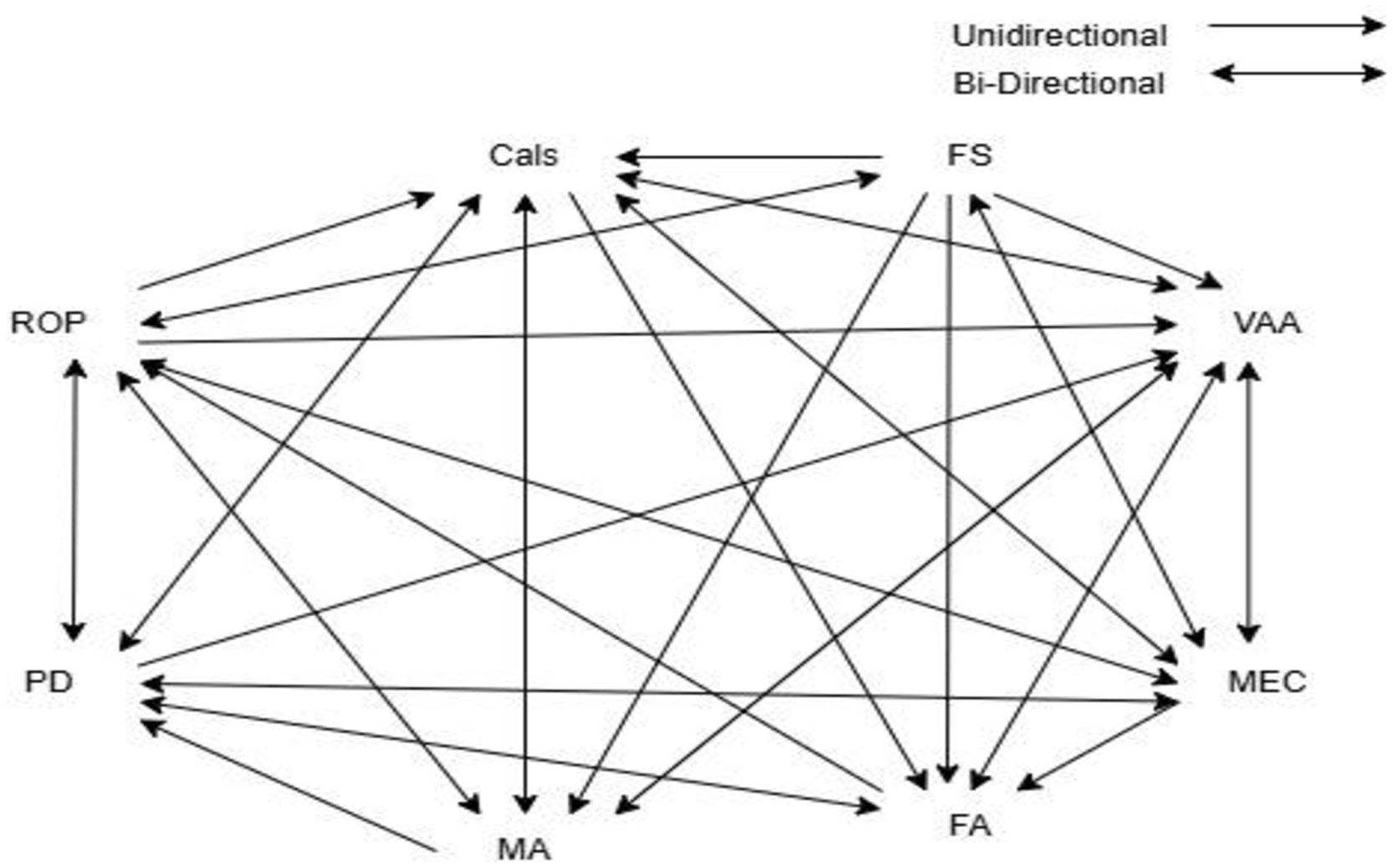- 1Department of Economics, College of Business Administration, Princess Nourah bint Abdulrahman University, Riyadh, Saudi Arabia
- 2Agricultural Economics Research Institute, Agricultural Research Center, Giza, Egypt
- 3Department of Agricultural Economics, Faculty of Agriculture, Beni-Suef University, Beni Suef, Egypt
- 4Institute of Agricultural and Resource Economics, University of Agriculture, Faisalabad, Pakistan
Introduction: Climate change is a serious threat to the global food production systems contributing to inflated food prices, especially in countries with scarce resources and lower share of domestic food production in their food security. Sustainable food systems can ensure food security and mitigate the effects of climate change on the natural ecosystems in these countries. Saudi Arabia, which is characterized by an arid climate and increasing climate vulnerability, faces inimitable challenges in achieving food security in 21st century. The country’s severe climatic conditions, including limited arable land and small freshwater resources, pose a substantial barrier to achieving Vision 2030 goals of economic diversification and reducing reliance on foreign foods. Thus, promoting sustainable food system approach can help Saudi Arabia achieve self-reliance on food production and ensure food security. Thus, the primary objective of this study is to explore the synergistic effect of agricultural mechanization, farm structure, gender dynamics, resource optimization, and agricultural value addition on sustainability of food systems and food security in Saudi Arabia.
Methodology: The autoregressive distributed lag bounds test and Granger Causality were used to analyze data from 1991 to 2019. Two different unit root tests augmented Dickey-Fuller and Phillips-Perron were applied to justify the integrated order of all variables.
Results: The results showed that farm structure, population density, agriculture value addition, and male and female participation significantly affected households’ food security in the short and long run. A 1% rise in agricultural value addition increases calorie supply by 653.3 kcal per day per capita. Similarly, for a 1 unit increase in farm structure, calorie availability in the country increased by almost 673 kcal per day per capita. Moreover, a one-unit increase in population density reduced calorie supply by 433.3 kcal per day per capita. Farm mechanization and resource-use efficiency significantly affect food security only in the short run.
Conclusion: The development of women-led agribusiness enterprises will strengthen Saudi Arabia’s agricultural sector while supporting the national gender equality objectives established in Vision 2030.
1 Introduction
The food and nutrition insecurity issue are expected to aggravate further despite global efforts owing to global traditional farming systems, climate change, and unsustainable consumption and production (Abd-Elmabod et al., 2020; FAO, 2017). Currently, 10% of the global population suffers from severe food insecurity (FAO, 2020). The increasing demand for food owing to the ever-growing world population puts pressure on food ecosystems, resulting in the exploitation of natural resources that could deteriorate and minimize soil fertility (Tóth et al., 2018). Furthermore, climate change has disastrous effects on agricultural productivity and food security (Haq et al., 2021). Moreover, the current food patterns and increasing demand for food items globally require more consumption of scarce natural resources (land and water), causing uncertainty regarding future food security. Thus, the issue of food security requires immediate attention from all stakeholders to address pressing food and nutrition security challenges (FAO, 2020). Addressing these issues requires a transition towards sustainable food systems that not only enhance agricultural productivity but also ensure long-term food security.
Sustainable food systems are essential for ensuring food security and achieving sustainable development goals worldwide (Avtar et al., 2020). Agriculture is a basic component of the global food system because it is not only the primary source of daily human diet, but also provides key ecosystem services to society (Rehman et al., 2022). More than 90% of calories and 80% of fat and protein intake are provided directly or indirectly by agricultural production systems (Viana et al., 2022). The sustainable food system approach ensures efficient resource management and decreases food waste along with minimizing environmental hazards, reducing the use of agrochemicals, and improving land preservation to produce healthy food for the global population. Thus, a sustainable food system approach is essential for minimizing food-related conflicts due to nutritional scarcity (United Nations, 2015).
The existing global food systems fail to meet nutritional needs of global population due to unsustainable farming practices. This requires transformative shifts in food production and resource management (Wu et al., 2018). A total of 822 million people suffer from undernutrition alongside 1.2 billion adults who are obese or overweight. Food production, processing activities, and waste management have created extensive pressure on environmental resources. Global food demand will increase by more than two-thirds by 2050, when the population exceeds 9 billion (FAO et al., 2018). The growing population requires sustainable and nutritious food, and a significant overhaul of the global food system is necessary to provide farms with sustainable incomes and nutritious products to consumers, with minimal negative environmental impacts (Singh et al., 2024). The main priority is to produce more food by utilizing the current resources while maintaining environmental stability.
The food security challenges are particularly pronounced in arid regions like Saudi Arabia due to scarce farming resources. Moreover, climate change aggravates the nation’s reliance on food imports to provide necessary diet to the Saudi Arabians. Thus, country ensures food security by importing food commodities, resulting in the depletion of billions of dollars. The country faces various threats to its overall food security through its limited agricultural resources as well as its dependence on imported food and trade policies, water scarcity, food losses, and climate change. It is one of the most arid places in both the Middle East and across the globe. Climate change affects every facet of life in the country and the agricultural sector is no exception. Climate change is now a reality in the country, including all over the world (Almazroui et al., 2017). Climate change induces lower yields and unpredictable output of staple food crops, which results in lower agricultural productivity creating food security issues for the country. The country has experienced substantial negative influences on agricultural production and water resources because of climate change. More than 90% of the cultivated crop land in the country is irrigated land; thus, climate change can lead to major yield losses. Cereals account for 38% of the cultivated land in the country. The cereal cultivation area in the country is decreasing (Abdalla, 2024). A decline in both crop yields and production levels tend to boost food and non-food commodity market prices. Thus, food security issues continue to be a major policy priority for the nation, because domestic food output cannot meet national requirements, leading to significant food imports. Saudi Arabia will become a completely food-importing nation by the year 2050 (Fiaz et al., 2018).
Thus, the increasing challenges of food security in Saudi Arabia necessitate a comprehensive approach that integrates mechanization, farm structure, gender dynamics, resource optimization, and value addition (El Bilali and Allahyari, 2018). While existing studies have extensively discussed the various factors influencing agricultural productivity, research remains limited on how these variables collectively impact food security, particularly in arid regions (Getahun et al., 2024; Talero-Sarmiento et al., 2023). Thus, the primary objective of this study is to explore the synergistic effect of agricultural mechanization, farm structure, gender dynamics, resource optimization, and value addition on food security and diversity in Saudi Arabia. Addressing these gaps will offer valuable insights for policymakers, agribusinesses, and researchers to develop sustainable, technology-driven, and inclusive agricultural strategies to enhance food security in water-scarce and climate-vulnerable regions.
The remainder of this paper is organized as follows: the second section elaborates on the agriculture and food security situation in Saudi Arabia. The third section, “review of literature” connects the different study variables with food security. The later section describes the different methods used to analyze the data in this study. The fifth section discusses the study’s findings, and discusses these results in light of previous studies. The final section presents the study’s conclusions, limitations, and policy recommendations.
2 Agriculture and food security situation in Saudi Arabia
The Kingdom of Saudi Arabia contains mostly desert land along with severe water shortages and is characterized by high temperatures and arid climates. It experienced four stages in the development of the agricultural sector. The first stage was initializing stage before 1990; during this time period, policy initiatives were aimed at stimulating the production of wheat in the country, which promoted the country as a major wheat exporter in the 1980s. The concentration stage occurred from 1990 to 2010, during which the field area decreased to approximately 8,110 km2. This decline was due to the policy shift from wheat production to livestock farming after 1990 and fodder crops were cultivated to promote the dairy industry. From 2010 to 2016 is an expansion stage in country’s agriculture; in this period, the number of fields and agricultural land reached at its peak. The number of fields was 33,961 comprising 9,400 km2 of farming land. Since 2016, a continuous decline in agriculture land has been observed in the country (Li et al., 2023).
The 8th development plan of the country for the agricultural sector focuses on the development of the agriculture sector to become a base for the economy. The basic objective of this plan was to enhance investment in the agricultural sector (Faruk, 2014). Currently, Saudi Arabia is trying to lower its dependence on the oil sector and to diversify its economy. Therefore, the growth of the agriculture sector and its value chain have received much attention in Vision 2030 as an untapped potential for growth (Emam et al., 2021).
The report highlights severe food insecurity in Saudi Arabia between 2015 and 2017 (Althumiri et al., 2021). A study conducted by Mumena (2021) pointed out moderate to severe food insecurity among study respondents in the country. Currently, the country’s agricultural and food security situation is facing various challenges. The basic challenges that hinder agricultural development and threaten food security are water scarcity and heavy reliance on food imports. Therefore, high dependency on irrigation with limited water resources generates difficult farming conditions in the country (Baig and Straquadine, 2014). The country also imports 80% of its food, which highlights a major vulnerability in food security (Faridi and Sulphey, 2019). However, the Kingdom of Saudi Arabia, with such low agriculture-favoring conditions, has successfully achieved self-sufficiency in production of some food items, particularly for fresh milk, dates, some vegetables, and eggs. Agriculture sector is the third largest contributor to the country’s GDP. This sector also provides sources of livelihood for millions of Saudi Arabians (Baig and Straquadine, 2014).
The government has started various programs to improve food security in the country. These initiatives focus particularly on water-saving technologies, such as hydroponics and greenhouse farming (Yusuf et al., 2025). Moreover, policies under the vision of 2030 signify that the country is taking important initiatives that enhance local production and productivity, while addressing inflation and increasing the finance for agriculture to lower the dependency on imports (Elneel, 2023). The government is taking effective initiatives to implement various agricultural programs to ensure food security and rural development (Fiaz et al., 2018).
3 Review of literature
Sustainable food systems demand a multifaceted approach that integrates farm mechanization, farm structure, value addition, gender dynamics, and resource optimization to enhance agricultural productivity, ensure environmental sustainability, and ensure global food security in current era. This section explores the critical role of these factors in relation to nations’ food security.
3.1 Farm mechanization and food security
Farm mechanization is necessary to increase agricultural productivity and ensure food security for the global population (Emami et al., 2018; Liu et al., 2025). Farmers in developing countries depend heavily on manual labor to operate within the agricultural sector, including harvesting activities (Fathallah, 2010). Farmers develop musculoskeletal conditions primarily because their work requires extended positions that demand awkward body postures and force them to lift heavy weight (Benos et al., 2020). Agricultural mechanization decreases dependence on human labor, while improving agricultural food quality, operation speed, and productivity of land resources (Abate and Kuang, 2021). Agricultural crop production benefits from mechanization because it boosts labor capabilities to sustain food supplies and decreases poverty in developing markets (Sims et al., 2016). Farm mechanization represents agricultural growth through the use of modern equipment and machinery (Amponsah et al., 2012). Rising labor wages combined with government subsidies have triggered a substantial increase in mechanization levels in agriculture (Yang et al., 2013).
Farm mechanization creates stronger resistance for farming households against different types of hazards and improves agricultural productivity, resulting in enhanced food security in nations. It also decreases farmers’ health risks by reducing physical farming activities (Olasehinde-Williams et al., 2020). It eliminates dangerous situations that occur during manual agriculture operations while creating opportunities for additional employment outside farming (Richards and Ramezani, 1990). Fram mechanization affects all four aspects of food security (food availability, economic and physical access to food, food utilization, and stability over time) (FAO, 2021a, 2021b). Through mechanization, there is enhanced protection against food loss during harvest periods with improved food safety standards (Daum, 2023). Sustainable agricultural mechanization leads to food independence along with economic growth, which includes all segments of society and helps advance sustainable agricultural primary objectives (Mrema, 2015). The wages farmers receive from mechanization improve access to better living conditions, while the reduced costs of production benefit families who purchase food in rural and urban areas. In such situations, food costs claim between 50 and 70% of household income (Liu et al., 2025). They are unable to obtain nutritious diets because financial limitations restrict their means. Fram mechanization eases the physical labor associated with manual agriculture, thus reducing the amount of energy required to limit caloric deficiencies and improve food security (Liu et al., 2025).
3.2 Farm structure and food security
Interest in agricultural land is increasing because of the growing population, inflated food prices, and food security concerns (Molotoks et al., 2021). Agricultural food supplies constitute the largest food source with essential ecosystem services. Several countries suffer from food insecurity owing to insufficient agricultural output caused by declining agricultural land per capita (Alami et al., 2021). Food security depends heavily on farm structures because of the accelerating climate change and increasing human population. Farming structures that utilize traditional farming approaches and rain-fed systems encounter higher exposure to climatic problems, leading to dangerous consequences for food production (FAO, 2021a, 2021b). Sustainable farming practices that unite conservation agriculture with agroecological systems have successfully protected smallholder farms through improved yield production and reduced environmental damage (Pretty et al., 2018; Tittonell and Giller, 2013). The adoption of sustainable farm practices is affected by multiple barriers including farm structure issues (small landholding, labor force deficiencies, financial constraints, etc.) (Barrett et al., 2017). Smallholder farmers can significantly boost food security through sustainable farming systems (Reardon et al., 2019).
Labor dynamics functions as a fundamental farm structure element that shapes the levels of food security in farms. Labor shortages emerge in regions where rural populations age together with high migration to urban areas, thus creating food security risks and decreasing farming productivity (Christiaensen and Todo, 2014). The implementation of farm technologies is hindered for smallholder farmers because they face financial challenges and lack necessary expertise (Fuglie et al., 2019). Cooperative farming systems and land reorganization programs show major potential in handling agricultural productivity and food security issues by improving access to resources and operational efficiency (Li et al., 2020). Farm structures play a pivotal role in agricultural sustainability and in ensuring global food security. Multiple crops under smallholder farms create diverse ecosystems that improve soil quality and protect the environment and food security yet need proper support from public institutions (Pretty et al., 2018). Farm structure has emerged as a major determining factor for food security because it directly affects productivity levels and sustainability alongside resilience factors. Public policies are required to ensure equal land access and technology for smallholder farmers to address different structural and sustainability issues (Touch et al., 2024). The world faces enormous challenges, such as climate change and increasing human population. Thus, farm structures and adopting sustainable farm practices are key to guaranteeing food security (Rehman et al., 2022).
3.3 Agriculture value addition and food security
Recent studies have demonstrated that agricultural value addition is a crucial element in boosting food security because of economic instability and changing climate patterns (Dos-Santos, 2020; Wijerathna-Yapa and Pathirana, 2022). The process of converting raw agricultural commodities into valuable products demonstrates substantial effectiveness in food availability through a reduction in postharvest losses. Paradigmatic techniques such as solar drying and cold storage systems improve the storage duration of fruits and vegetables. Post-harvest losses in the agricultural sector require immediate attention because they represent a major threat to food sustainability (Sheahan and Barrett, 2017; Kumar and Kalita, 2017). Agricultural value addition transforms crops into refined products, including flour, oils, and dried goods, which improves food choices. In addition, it decreases monoculture dependence, thus extending food availability throughout different seasons (Dahal et al., 2024).
Value addition to agricultural products positively affects accessibility, because it enables farmers to reach profitable high-value markets. Smallholder farmers convert milk into yogurt and cheese, thus providing sustainable income and better food availability for their households (Touch et al., 2024). The development of food value addition enables the establishment of important facilities for processing and storage, alongside strengthened market links. This will enable faster and fresh healthy delivery of food to consumers (Fagbemi and Oluwajuyitan, 2020). Agricultural value addition is fundamental for increasing food utilization because it enhances the dietary nutritional content of food products (Dos-Santos, 2020). Staple foods fortified with iron and biofortified with vitamin A are successfully reduce micronutrient deficiencies in developing nations (Hombali et al., 2019). Traditional food processing techniques, such as fermentation and germination, eliminate anti-nutritional components that make food more digestible and nutritious (Nkhata et al., 2018). Recent advancements have played a critical role in addressing malnutrition and food insecurity in many areas. Agricultural value addition establishes food systems that can survive unexpected incidents, including climate change and economic downturns, thus ensuring food stability. Regions exhibiting frequent climate disruptions require agricultural value addition to be used as food shortage shields against such events.
3.4 Gender dynamics in agriculture and food security
The gender dynamics in farming influence how successfully agricultural resources are used, and how food systems maintain their stability (Bryan et al., 2023). In addition, they affect resource sharing along with agricultural productivity levels. The worldwide female share of agricultural workers reaches 43%, while Africa and Asia have population percentages above 50% (FAO, 2011). Female farmers make important agricultural contributions; however, they face numerous systemic barriers. They lack access to land ownership together with basic farm resources, including credit and educational services, technology, and appropriate extension services. This inequality impairs production capability and at the same time strengthens the persistence of poverty and food insecurity. When female farmers obtain equal access to agricultural resources like those given to male farmers, agricultural output would rise by 20–30% thereby lifting millions out of food insecurity and malnutrition (FAO, 2011).
Agricultural food security initiatives face additional challenges because women perform different workload tasks from men in farming. Women handle core farming tasks, food processing work, and nutritional duties, while basic leadership functions and cash crop management responsibilities mainly fall under male control (Visser and Wangu, 2021). The segregated labor system results in an unequal distribution of resources and priorities, leading to undervalued food-producing activities that cannot sustain household nutrition (Quisumbing et al., 2014). The heavy unpaid care burden women carry diminishes their ability to join productive agricultural work, which ultimately leads to increased food insecurity at home. The difficulties faced by agricultural female farmers become substantially more severe because women tend to be more exposed to the disastrous impacts of climate change (Dibakoane et al., 2022). This is primarily because women have limited access to adaptive technologies and essential resources. Areas affected by prolonged droughts and erratic rainfall patterns make female farmers vulnerable to crop failures because they depend on traditional farming practices with rain-fed agriculture (UN Women, 2022). Establishing food systems resistant to environmental disturbances requires specific attention to gender-based risks. Women’s support in agricultural leadership creates widespread social and economic advantages that are selected simply by obtaining safe food supplies (Bryan et al., 2023). Women who achieve financial independence through resource control tend to dedicate their earned money to enhancing their families’ health levels and nutritional requirements. The positive effects generated from this scenario strengthen the overall food security of communities (World Bank, 2014). Achieving sustainable food security depends heavily on gender equality-focused policies and interventions that include land distribution reforms and improved access to credit and gender-focused extension services (Quisumbing and Doss, 2021). Tackling gender differences in agricultural production leads to enhanced food security. Raising women’s agricultural participation rates will enable the world to exploit female farmers’ complete potential, boost agricultural yields, and establish stronger food systems (Bryan et al., 2023).
3.5 Resource optimization and food security
The relationship between resource management and food security exists because the sustainable control of essential natural resources, including water, soil, and energy, directly affects operational food production stability (Pinstrup-Andersen and Pandya-Lorch, 1998). Inadequate resource management creates greater food insecurity, but sustainable techniques lead to substantial improvements in food security (Mekonnen et al., 2024). Water is the principal factor in agriculture because it accounts for 70% of the total global freshwater usage. Water scarcity develops when improper extraction methods and inefficient irrigation techniques are combined to deplete available water reserves, thereby reducing both agricultural harvest output and national food yields (Ingrao et al., 2023).
Agricultural production receives vital support from sustainable water management practices including drip irrigation and rainwater techniques, particularly in water-scarce areas (Chartzoulakis and Bertaki, 2015; Penuelas et al., 2023). The implemented methods lead to better agricultural sector productivity, while strengthening food security (Barrett, 2021). Food security is in danger due to soil degradation resulting from overfertilization practices and failing land management and deforestation operations, which decreases cropland fertility (Pozza and Field, 2020). Soil health recovery through sustainable practice, including crop rotation with conservation tillage techniques, improves food production. Soil conservation practices integrated into farming systems offer great potential for building climate change resilience, which helps sustain better food security levels in developing nations (Şimşek, 2025; Sher et al., 2024).
The entire food system requires substantial energy consumption to maintain food security because agricultural production to food distribution phases is highly energy-demanding (Corigliano and Algieri, 2024; Menconi et al., 2022). Renewable and efficient energy strategies can reduce the environmental effects of food systems and maintain reliable food availability (Corigliano and Algieri, 2024). Climate-resilient practices represent an invaluable method for enhancing food security throughout regions where climate change has the greatest impact (FAO, 2020). Sustainable food production depends heavily on biodiversity because natural processes such as pollination, pest management and nutrient cycling help farmers secure food availability. Excessive use of natural resources, particularly deforestation and destructive fishing, increases the risk of essential food security services (Shahbaz et al., 2022a, 2022b). The key to maintaining sustainable food security throughout the years depends on effective measures for biodiversity preservation and ecological system management (Varzakas and Smaoui, 2024). The adoption of resource-friendly operations improves food safety outcomes (Vågsholm et al., 2020; Shahbaz et al., 2022a, 2022b).
4 Materials and methods
4.1 Data source
Yearly data were used in this study covering the period from 1991 to 2019. The data on variables were collected from two sources, as our world in data were accessed to obtain data on the countries’ calorie supply, mechanization, farm structure, resource optimization, and male and female participation in agriculture, which is sourced by the Food and Agriculture Organization (FAO). The data regarding agricultural value addition (percent of GDP) and population density (people per square kilometer of land area) were obtained from World Development Indicators (WDI). The indicators to measure farm structure include three indicators: labor force share in agriculture (%), agricultural land per capita, and arable land needed for producing crops (index). Total factor productivity (TFP) is used as a proxy for resource optimization and the data were analyzed using STATA 21. Table 1 describes the study variables.
By including the above variables, the following functional form was specified, which includes calorie supply over the years as the dependent variable, and the remaining seven variables were considered as independent variables.
where Cal, FS, ROP, VAA, PD, MEC, MA, and FA indicate calorie supply, farm structure, resource optimization, agricultural value addition, population density, mechanization, males in agriculture, and females in agriculture, respectively. shows the unknown coefficients to be measured, and depicts the error term.
4.2 Unit root tests
The autoregressive distributed lag (ARDL) cointegration approach does not require unit root pre-testing because it can be applied to a set of variables of order I(0), I(1), or mixed. The ARDL bounds test requires all variables to be integrated of order 0 or 1, and no variable is integrated of order I(2) (Pesaran and Shin, 1999; Pesaran et al., 2001). Therefore, to justify the integrated order of all variables, two different unit root tests were applied: augmented Dickey-Fuller (ADF) and Phillips-Perron (PP).
4.3 Testing cointegration
The ARDL bound test-based F-statistics were used to determine the existence of long-run relationships among the variables. The ARDL approach has many advantages over the traditional cointegration approach, as the ARDL approach is flexible and allows analysis with an integrated order of 0 or 1. Its application and interpretation are very simple owing to its single equation set as well as different lag lengths for different variables, and it is very suitable for small sample sizes. It also provides unbiased estimates for long-run relationships and adequately addresses autocorrelation and endogeneity (Jalil and Ma, 2008; Harris and Sollis, 2005).
The null hypothesis (H0 = no cointegration) would be rejected if the F-statistic value exceeds the upper bound value, and accepted if the F-statistic value remains lower than the lower bound value, while if the F-statistic value falls between the lower bound and upper bound, then it is unclear whether cointegration exists (Pesaran et al., 2001). Therefore, the following cointegration model is specified by exploring the long-run relationships among the variables.
Where, △ indicates the change operation, and is the optimal lag number based on the lag length criterion depicted by t−1, and to and to are the elements to be examined. From the above equation, the following hypothesis was analyzed to determine the cointegration among the variables.
If the f-statistics value exceeds the upper bound, then H0 is rejected, and cointegration among variables exists; then, the short-and long-run ARDL models are examined.
where ECT is the error correction term that indicates the speed of adjustment from the short-run shock to the long-run equilibrium. It must be negative and significant, with a value of less than 1.
4.4 Diagnostic tests of the model
The most important assumption of the ARDL bound test is that the error term is serially independent and normally distributed. For this purpose, several tests were employed to analyze autocorrelation, heteroskedasticity, and normality. For autocorrelation, the Breusch–Godfrey LM test and Durbin–Watson d-statistic for heteroskedasticity, White’s test, and Breusch-Pagan-Godfrey test were used. For normality, the Jarque-Bera test was used.
Thus, it is necessary to confirm the stability of a model with an autoregressive structure. For this purpose, the cumulative sum of recursive residuals (CUSUM) and cumulative sum of recursive residuals of squares (CUSUMQ) (Brown et al., 1975) tests were used. A similar method was proposed by Pesaran and Pesaran (1997) to determine the parameter stability. Figure 1 shows the methodology used in this paper.
5 Results
The trend in Cals per day per capita is presented in Figure 2, which indicates that calories per capita in Saudi Arabia fluctuated greatly over the period from 1991 to 2019. However, there was a long-term increase in the Cals per day per capita. In the starting years (1991–1994), there was a steady decline in calories, dropping from 2879 kcal to 2677 kcal. From 1995 to 2006, calories per day per capita gradually recovered. The number of calories per day per capita increased, with some fluctuations by 1995, reaching 3,043 kcal in 2006. After 2006, a dip in calories per day per capita was observed from 2007 to 2009, and it has been decreasing, which is strongly linked with the global financial crisis of 2008. Afterward, a continuous rise was observed in the Cals over the period of 2011–2016, and reached its peak of 3,237 kcal in 2016, and stabilizing around 3,219 kcal in 2019. Cereals are the main source of energy and protein in the country, which comprises of 40–41%. In 1980/90, the availability of grains decreased to a dangerous level, as the availability of millet, sorghum, and corn decreased by 64%. Over the period to 2001–07, the supply of vegetables per day per capita was reduced, while the supply of dairy products, such as meat, milk, animal fats, and fish, increased greatly (Adam et al., 2014).
Figure 3 shows the percentage change in Cals over the years; the overall change in Cals over the period–1991-2019 was positive. Considering the first 4 years (1991–1994), Cals was reduced by −3.56% in 1992. In 1995, the Cals increased, but suddenly decreased in later years until 1998. Subsequently, caloric supply fluctuated from 1999 to 2006 and remained positive. In 2007, the supply of calories decreased sharply in 2008, which may be due to the global crisis of 2008. In the following years, the supply of calories increased and stabilized, with no major improvements or disruptions.
Global standards for energy requirements for children, males, and females over age are defined according to sedentary and active lifestyles. Here, we consider the two calorie requirements that cover males, females, and children to compare the Cals in Saudi Arabia over the years. Figure 4 presents that the Kingdom of Saudi Arabia had maintained the Cals per day per capita for an active lifestyle over the period–1991 to 2013. After 2013, the Cals exceeded the calorie requirements for an active lifestyle, indicating excess food availability, which may lead to overconsumption, food loss, or obesity risk.
5.1 Unit root test
Table 2 presents the outcomes of two different unit root tests: ADF and PP. The first stationarity level of variables was tested by considering only constant, and then the trend option was added with a constant term to check the robust outcomes regarding stationarity of variables. The findings revealed that both ADF and Phillips Peron confirmed that all the variables were stationary at the first difference; hence, the order of integration for all variables is I(1). For the ARDL bound testing proposed by Pesaran and Shin (1999) and Pesaran et al. (2001), both ADF and PP unit root tests also confirmed that there is no variable of order I(2).
5.2 Optimal lag selection
Determining the optimal lag length is an empirical issue, and there is no rule of thumb for determining the optimal lags for the variables. The selection of too few lags can cause a specification error, whereas too many lags cause the problem of multicollinearity. Moreover, the sample size and selection criteria significantly affect the selection of optimal lags. For annual data, usually one or two lags, for quarterly data, a maximum of eight lags for monthly data up to 24 lags is suitable (Godil et al., 2022). There are five different types of selection criteria to determine the optimal lags for each variable: likelihood ratio, Akaike information criteria, final prediction error, Schwartz information criteria, and Hannah-Quinn information criteria. Based on these two conditions of sample size and selection criteria, we first focus on the selection criteria. Based on the Akaike Information Criterion, we found the optimal lags for each variable except for males in agriculture, which had an optimal lag of 4. Then, considering the sample size, we assumed the optimal lag for this variable to be equal to 2, and ARDL (2,2,2,2,2,2,2,2) was specified.
The above specified model has passed all the diagnostic tests as the R square is 0.97, and the adjusted R square is 0.94, which implies that the variables explain 97% of the variation in the Cals, which indicates the high explanatory power of the model. Autocorrelation tests, such as the Durbin-Watson and Breusch-Godfrey LM tests, confirm that there is no autocorrelation, and the model is not spurious. Similarly, the F-statistics (=252.22 at p-value = 0.00) also indicate that the null hypothesis is rejected, which shows that the variables have non zero coefficients. Table 3 indicates that the model has also passed all other diagnostic tests regarding heteroskedasticity and Jarque-Berra normality.
5.3 ARDL bound test
ARDL is a model specifically used for testing long-run relationships among variables. The ARDL bound test developed by Pesaran et al. (2001) identifies the existence of cointegration or long-run relationships among the variables. Table 4 presents the ARDL bounds test’ outcomes the F-value greater than the upper bound indicates the long-run association do exist between the variables.
5.4 Short run and long run impact of variables
Table 5 presents both long-and short-run relationships between the dependent and independent variables. The findings indicate that the coefficients of FS, PD, VAA, MA, and FA are statistically significant. This implies that these variables strongly affect Cals in the long run, leading to higher food security in the country. These variables are crucial for improving food security by increasing Cals in the long run and improving farm productivity, distribution, and accessibility to food items. The significantly negative value of the lagged error correction term (ECT) highlights how quickly the system returns to equilibrium after a shock in the short run. The negative coefficient of ECT −0.503 indicates that the long-run relationship among the variables is stable, and 50.3% of the deviation from the previous period’s equilibrium in the short run is correctly backed to its equilibrium in the current period.
FS often indicates the size of the farm, which plays a crucial role in determining the farm scale and farm productivity. As the findings indicates 1 unit increase in FS, caloric availability in the country will increase by almost 673 kcal per day per capita. As the FS improves, the adoption of sustainable and efficient farm practices also increases. The adoption of new farm technologies makes farms more productive and profitable through stable food production and supply, which ensures a stable caloric supply for the growing population. Therefore, changes in FS led to the integration of innovations in cropping systems, which greatly affects farmers’ incomes and nutritional outcomes. For example, an efficient cropping system can increase soil fertility and improve the Cals for farm families (Prusty et al., 2022). The author described that adjustments in existing crop systems at farms and the adoption of a new efficient FS can improve farm productivity, performance, and sustainability. On the other hand, FS also positively and significantly influences Cals in the short term. The low and significant positive coefficient of FS (first difference = D1) indicates that FS can enhance calorie supply through immediate changes in farm size, land use, and cropping pattern. Similarly, the significant and large positive coefficient of FS (lagged difference = LD) signifies that past adjustments in the FS of country have a more substantial impact on Cals, which indicates that adjustments in FS need some time or lag before materializing the impact of FS on food production and Cals. Therefore, in the short run, adjustments in FS have beneficial outcomes in the form of a high-Cals, but the most favorable gains are realized as past adjustments and improvements in FS. This requires continuous adjustments in the FS to obtain optimal effects on Cals to improve the food security of the country. Hongqing et al. (2021) also describe that the optimizing the land use or improving the FS substantially contributes to the farm benefits especially the food security of the farm families. Similarly, Vatta (2024) determined the favorable and diversified impacts of optimizing FS on farm income, food security, and nutritional outcomes. They reported that a properly adjusted FS substantially contributes to accessibility to food, diet diversity, and nutritional outcomes.
PD strongly affects Cals in both the long and short run. In the long run, a one-unit increase in PD reduces calorie supply by 433.3 kcal per day per capita, while the negative impact of PD indicates that it exerts great pressure on calorie supply because of limited food resources, land, and infrastructure. The negative and significant coefficient of PD at the first difference signifies that the rapid increase in PD in the country lowers calorie supply per capita in the short run. This may be due to the gap between food production and the increase in PD, which disrupts the food supply on an immediate basis. Similarly, high PD also causes farmland fragmentation, which reduces farm size, productivity, and food supply. Popp et al. (2013) highlighted that an increase in PD increases the demand for food by 70%, causes changes in food consumption patterns, and lowers the availability of land for food production, which results in a low supply of calories per capita. Widhiyastuti et al. (2023) determined that in 2019–19 the PD increase by 22.88 people per kilometer square, and over the same time period harvested are and production of rice decreased. Therefore, although food production is increasing globally, the average food self-sufficiency at the country level has been decreasing over the past half-century, and PD is one of the main reasons; by 2010, economies with high PD and urbanization had large deficits in food production (Schramski et al., 2019).
The significant and positive coefficient of VAA indicates that VAA strongly influences calorie supply over time. This implies that a 1% increase in VAA increases calorie supply by 653.3 kcal per day per capita. This indicates that VAA over time substantially enhances calorie supply by improving food availability and lowering food losses. Moreover, the lower coefficient of first difference (=94.58) in the short run as compared to the lagged difference (=194.38) indicates that immediate VAA also improves the calorie supply in the country, while their full impact takes time to materialize. VAA enhances production efficiency and food supply. The adoption of high-yielding crop varieties and value-added practices at farms optimizes the use of land and increases crop yield (Vatta, 2024), which increases food availability (Malec et al., 2023; Sarwar, 2025). VAA to farm products enhances the shelf life of farm products and lowers the spoilage risk of food, which leads to high food availability throughout the year by ensuring food availability during food scarcity (Ceesay et al., 2021; Ogutu et al., 2020). Moreover, VAA also improves food accessibility through wide distribution across different regions of the country, which leads to high market access owing to long shelf life and easy transportation, thereby enhancing food availability in diverse regions (Hazrana and Mishra, 2025: Breisinger et al., 2019).
The significant positive impact of MA over the years indicates that the long-run impact of male participation in agricultural activities in the country is stronger than the short-term impact on caloric supply. Males perform various farming activities such as mechanization and agro-processing, which enhance farm production and efficiency. Male farmers are commonly busy using farm machinery and irrigation, which enhances the production per unit of land. Similarly, male farmers are more capable of cultivating larger areas of land through learning and adopting modern farming techniques. Moreover, humans invest in efficient farm technologies, such as irrigation, which improves food production. Over time, male farmers can accumulate capital and reinvest in their farms, thereby expanding food production and the supply of calories across the country. Therefore, male farmers are more likely to commercialize their farms, which improves their household nutrition and leads to a high-calorie supply (Mgomezulu et al., 2024). They described that in the long run, male farmers are more likely to engage in commercial farming, enhancing their productivity and farm production, leading to high food availability and calorie supply. Moreover, male farmers’ involvement in food sales enhances their family income, which increases their diet diversity, leading to high calorie content, and they are more likely to engage in farming endeavors that directly improve their diet diversity (Yusriadi et al., 2024).
The coefficient of FA indicates that female participation in agriculture strongly enhances caloric supply in the long run, whereas it has a significant negative impact on caloric supply in the short run. This negative impact may be explained by structural barriers, initial productivity disruption, and an inefficient labor market. Historically, low female participation in agriculture is highly linked with cultural and social barriers (Ragasa, 2012), and a sudden increase in female participation in agriculture may require skills, disrupt labor efficiency, and face challenges in male-dominated farming activities. Moreover, the involvement of females in agriculture may not have easy access to the necessary farm resources, which lowers their contribution to calorie supply in the short run. Abdelali-Martini (2011) highlights that the females lack the necessary resources like land, credit and also have limited decision-making power which limited their role in enhancing farm productivity in Middle East and North Africa countries. In the long run, female participation in agriculture gains experience and becomes more productive, contributing to high farm production over time. Das et al. (2023) described the importance of gender equity for development of sustainable and healthy diets, as they highlight that the female role in food systems is very crucial in low-and middle-income economies agriculture as they are structurally disadvantages.
The findings of the ARDL model indicate that ROP and MEC have a strong positive impact in the short run. ROP has a delayed impact on the supply of calories, whereas MEC has an immediate impact on calorie supply. The immediate impact of MEC on farms is primarily positive, and it improves farm efficiency and productivity, which ultimately enhances food availability, resulting in a high-calorie supply. MEC reduces the impact of labor shortages on farms and enhances farm operations. It also increases farm production through appropriate land preparation. Yasar et al. (2024) determined that MEC enhances the food availability by almost 125% in developing economy which results in high food security. Moreover, MEC increased net farm income by 31%, family income by 19%, and food consumption by 5%, which justifies its immediate positive impact on calorie supply (Jena and Tanti, 2023). However, the delayed impact of ROP indicates that resource efficiency needs to adopt efficient technologies that require time to obtain the materialized impact of ROP on Cals.
5.5 Model stability
For robustness, we applied the structural stability test, which confirms the stability of the long-run outcomes. For this purpose, we used the CUSUM and CUSUMQ. Figure 5 presents CUSUM and Figure 6 shows CUSUMQ, and both figures indicate that CUSUM and CUSUMQ remain within the critical bounds of 5%. This signifies the constancy of the parameters and stability of our study model, as both CUSUM and CUSUMQ do not cross the straight lines of the critical bounds.
5.6 Granger causality
After determining the long-run relationships among the variables, we used the Granger causality test to analyze the causality between the variables. Owing to cointegration, unidirectional or bidirectional causality between the variables is expected. The findings of Granger causality highlight that FS has a strong causal relationship with Cals at 5%, while reverse causality is not significant, which implies that improving FS can significantly affect the Cals in the country. Similarly, ROP also causes unidirectional Granger causes Cals, and implies that ROP can strongly influence Cals. The outcomes regarding VAA, PD, MEC, and MA indicate that these variables have a bidirectional causality relationship with coal. Table 6 presents the findings of Granger causality for all variables and Figure 7 shows a graphical representation of causality among the variables.
6 Conclusion and policy recommendations
The growing population and rising risks of climate change have led to increased food and nutrition insecurity worldwide. In this context, sustainable food systems are key because they can ensure global food security and climate change mitigation. Agriculture is the cornerstone of world food systems as it fulfills human dietary needs by supplying important calorie and nutrient resources. However, it remains one of the leading consumers of natural resources worldwide. Agriculture is mostly characterized by a lower level of productivity, especially in countries with arid environments and climate change risks. Sustainable food systems can improve agricultural productivity in arid regions because they emphasize the efficient use of natural resources, farm mechanization, and agricultural value addition, resulting in improved dietary intake of the global community.
Saudi Arabia, characterized by an arid climate and increasing climate vulnerabilities, faces unique challenges in achieving food security. Sustainable agricultural growth continues to face extreme difficulties in Saudi Arabia because of its challenging natural environment which produces limited freshwater sources and small amounts of arable land along with severe temperatures. Saudi Arabia needs to import most of its food to fulfill national food needs. Food security remains central to Saudi Arabia’s Vision 2030 while the country aims to increase agricultural production decrease external food reliance and enhance environmental resource practices.
Thus, promoting a sustainable food system approach can help Saudi Arabia’s objective of achieving self-reliance in food production to ensure food security. Farm mechanization together with efficient resource utilization, agricultural value addition, farm structure, and gender inclusion can improve productivity levels. Even though several studies have examined individual effects of these factors on food security, none of the studies explored their collective impact on food security in Saudi Arabia. Thus, the primary objective of this study is to explore the synergistic effect of agricultural mechanization, farm structure, gender dynamics, resource optimization, and agriculture value addition on food security in Saudi Arabia. The study used the ARDL model to analyze the data from 1991–2019 of the country. Two different unit root tests ADF and PP were applied to justify the integrated order of all variables.
The findings indicate that the coefficients of farm structure, population density, value addition, and male and female participation are statistically significant in the short and long run. This implies that these variables strongly affect households’ food security in the long run, leading to higher food security in the country. Farm mechanization and resource use efficiency only significantly affect food security in the short term. For example, a 1% rise in agricultural value addition increases calorie supply by 653.3 kcal per day per capita. Similarly, for 1 unit increase in farm structure, calorie availability in the country will increase by almost 673 kcal per day per capita. In the long run, a one-unit increase in population density reduces calorie supply by 433.3 kcal per day per capita. The coefficient of females in agriculture indicates that female participation in agriculture strongly enhances calorie supply in the long run, while it has a significant negative impact on calorie supply in the short run.
Based on these results, the following policy recommendations are made to improve the country’s food security. The country needs to invest in agri-processing facilities, together with food preservation systems and supply chain construction, to achieve sustained food calorie supply enhancement. Agriculture food processing and packaging industries should receive encouragement through policy support because this will decrease losses during harvest storage and make nutrient-rich foods easily available. This aligns with the Saudi Vision the 2030s goals of diversifying the economy and decreasing reliance on food imports. Further, the country should develop training initiatives combined with financial programs and policy modifications that support women’s agricultural work. Women will have the greater impact on food security by receiving access to contemporary agricultural equipment alongside digital agricultural systems and business start-up opportunities. The development of women-led agribusiness enterprises will strengthen Saudi Arabia’s agricultural sector, while supporting the national gender equality objectives established in Vision 2030.
Although the study was carried out with utmost care, it has a few limitations that must be kept in mind when generalizing the study findings. This study focuses on the ARDL bound test and Granger causality analysis, and does not consider any possible structural breaks or regime shifts that may have occurred due to economic shocks, policy changes, and environmental disruptions. Moreover, this study did not analyze the spatial variations that may provide more comprehensive insights by considering the different agro-ecological zones of the county. Although the study considered gender dynamics, the lack of socioeconomic factors limited its ability to broadly explain the different aspects of food security. Mechanization is very important to enhance the productivity of food crops, but studies could not incorporate water-saving technologies in the analysis, which is also an important factor that may be considered in future studies in the context of Saudi Arabia.
Data availability statement
The original contributions presented in the study are included in the article/supplementary material, further inquiries can be directed to the corresponding authors.
Author contributions
FM: Writing – review & editing, Funding acquisition, Investigation, Data curation, Software, Writing – original draft, Conceptualization. AM: Data curation, Project administration, Writing – original draft, Supervision, Writing – review & editing, Methodology, Formal analysis. ME: Visualization, Methodology, Project administration, Writing – original draft, Validation, Writing – review & editing, Resources. MI: Writing – review & editing, Supervision, Writing – original draft, Resources, Visualization, Project administration. AS: Writing – review & editing, Visualization, Resources, Project administration, Writing – original draft, Formal analysis, Validation. AA: Conceptualization, Writing – review & editing, Writing – original draft, Funding acquisition, Resources, Investigation, Visualization.
Funding
The author(s) declare that financial support was received for the research and/or publication of this article. The study was funded by Princess Nourah bint Abdulrahman University Researchers Supporting Project number (PNURSP2025R260), Princess Nourah bint Abdulrahman University, Riyadh, Saudi Arabia.
Acknowledgments
The authors gratefully acknowledge the support given by Princess Nourah bint Abdulrahman University Researchers Supporting Project number (PNURSP2025R260), Princess Nourah bint Abdulrahman University, Riyadh, Saudi Arabia.
Conflict of interest
The authors declare that the research was conducted in the absence of any commercial or financial relationships that could be construed as a potential conflict of interest.
Generative AI statement
The authors declare that no Gen AI was used in the creation of this manuscript.
Publisher’s note
All claims expressed in this article are solely those of the authors and do not necessarily represent those of their affiliated organizations, or those of the publisher, the editors and the reviewers. Any product that may be evaluated in this article, or claim that may be made by its manufacturer, is not guaranteed or endorsed by the publisher.
References
Abate, M. C., and Kuang, Y. P. (2021). The impact of the supply of farmland, level of agricultural mechanization, and supply of rural labour on grain yields in China. Stud. Agric. Econ. 123, 33–42. doi: 10.7896/j.2081
Abdalla, I. F. (2024). “Domestic food production and consumption in Saudi Arabia: Status quo and future prospects” in Food and Nutrition Security in the Kingdom of Saudi Arabia, vol. 1. eds. A. E. Ahmed, J. M. Al-Khayri, and A. A. Elbushra (Cham: Springer).
Abdelali-Martini, M. (2011). Empowering women in the rural labor force with a focus on agricultural employment in the Middle East and North Africa (MENA). Expert paper.
Abd-Elmabod, S. K., Muñoz-Rojas, M., Jordán, A., Anaya-Romero, M., Phillips, J. D., Jones, L., et al. (2020). Climate change impacts on agricultural suitability and yield reduction in a Mediterranean region. Geoderma 374:114453. doi: 10.1016/j.geoderma.2020.114453
Adam, A., Osama, S., and Muhammad, K. I. (2014). Nutrition and food consumption patterns in the Kingdom of Saudi Arabia. Pak. J. Nutr. 13:181. doi: 10.3923/pjn.2014.181.190
Alami, I., Dixon, A. D., and Mawdsley, E. (2021). State capitalism and the new global development regime. Antipode 53, 1294–1318. doi: 10.1111/anti.12725
Almazroui, M., Islam, M. N., Saeed, S., Alkhalaf, A. K., and Dambul, R. (2017). Assessment of uncertainties in projected temperature and precipitation over the Arabian Peninsula using three categories of CMIP5 multimodel ensembles. Earth Syst. Environ. 1:23. doi: 10.1007/s41748-017-0027-5
Althumiri, N. A., Basyouni, M. H., Duhaim, A. F., AlMousa, N., AlJuwaysim, M. F., and BinDhim, N. F. (2021). Understanding food waste, food insecurity, and the gap between the two: a nationwide cross-sectional study in Saudi Arabia. Foods 10:681. doi: 10.3390/foods10030681
Amponsah, S. K., Oteng-Darko, P., and Kumi, F. (2012). Potential and constraints of agricultural mechanization in Ghana–a review. Int. Agric. Eng. J. 21, 38–43.
Avtar, R., Aggarwal, R., Kharrazi, A., Kumar, P., and Kurniawan, T. A. (2020). Utilizing geospatial information to implement SDGs and monitor their Progress. Environ. Monit. Assess. 192, 1–21. doi: 10.1007/s10661-019-7996-9
Baig, M. B., and Straquadine, G. S. (2014). Sustainable Agriculture and Rural Development in the Kingdom of Saudi Arabia: Implications for Agricultural Extension and Education. In: Behnassi, M., Syomiti Muteng’e, M., Ramachandran, G., Shelat, K. (eds) Vulnerability of Agriculture, Water and Fisheries to Climate Change. Springer, Dordrecht. doi: 10.1007/978-94-017-8962-2_7
Barrett, C. B. (2021). Overcoming global food security challenges through science and solidarity. Am. J. Agric. Econ. 103, 422–447. doi: 10.1111/ajae.12160
Barrett, C. B., Christiaensen, L., Sheahan, M., and Shimeles, A. (2017). On the structural transformation of rural Africa. J. Afr. Econ. 26, i11–i35. doi: 10.1093/jae/ejx0009
Benos, L., Tsaopoulos, D., and Bochtis, D. (2020). A review on ergonomics in agriculture. Part I: manual operations. Appl. Sci. 10:1905. doi: 10.3390/app10061905
Breisinger, C., Raouf, M., Thurlow, J., and Wiebelt, M. (2019) Beyond the business case for agricultural value chain development: an economywide approach applied to Egypt monitoring survey (No. 18). International Food Policy Research Institute (IFPRI)
Brown, R. L., Durbin, J., and Evans, J. M. (1975). Techniques for testing the constancy of regression relationships over time. J. R. Stat. Soc. Ser. B Stat Methodol. 37, 149–163. doi: 10.1111/j.2517-6161.1975.tb01532.x
Bryan, E., Ringler, C., and Meinzen-Dick, R. (2023). “Gender, resilience, and food systems” in Resilience and food security in a food systems context. Palgrave Studies in Agricultural Economics and Food Policy. eds. C. Béné and S. Devereux (Cham: Palgrave Macmillan).
Ceesay, E. K., Francis, P. C., Jawneh, S., Njie, M., Belford, C., and Fanneh, M. M. (2021). Climate change, growth in agriculture value-added, food availability and economic growth nexus in the Gambia: a granger causality and ARDL modeling approach. SN Bus. Econ. 1, 1–31. doi: 10.1007/s43546-021-00100-6
Chartzoulakis, K., and Bertaki, M. (2015). Sustainable water management in agriculture under climate change. Agric. Agric. Sci. Procedia 4, 88–98. doi: 10.1016/j.aaspro.2015.03.011
Christiaensen, L., and Todo, Y. (2014). Poverty reduction during the rural–urban transformation–the role of the missing middle. World Dev. 63, 43–58. doi: 10.1016/j.worlddev.2013.10.002
Corigliano, O., and Algieri, A. (2024). A comprehensive investigation on energy consumptions, impacts, and challenges of the food industry. Energy Convers. Manage. X 23:100661. doi: 10.1016/j.ecmx.2024.100661
Dahal, B., Kimmerer, C., and Hailu, G. (2024). “Value added to agricultural commodities” in Future food systems (Cambridge, MA, USA: Academic Press), 89–107.
Das, A., Kasala, K., and Kumar, S. (2023). Gender inclusive food systems for sustainable healthy diets in low and middle-income countries. Agroecol. Sustain. Food Syst. 47, 1052–1074. doi: 10.1080/21683565.2023.2215192
Daum, T. (2023). Mechanization and sustainable Agri-food system transformation in the global south. A Review. Agron. Sustainable Dev. 43:16. doi: 10.1007/s13593-023-00868-x
Dibakoane, S., Siyongwana, P., and Shabalala, A. N. (2022). Vulnerability, impact and adaptation strategies of female farmers to climate variability. Jamba J. Disaster. Risk Stud. 14:1302. doi: 10.4102/jamba.v14i1.1302
Dos-Santos, M. J. P. L. (2020). “Value addition of agricultural production to meet the sustainable development goals” in Zero Hunger. Encyclopedia of the UN Sustainable Development Goals. eds. W. Leal Filho, A. Azul, L. Brandli, P. Özuyar, and T. Wall (Cham: Springer).
El Bilali, H., and Allahyari, M. S. (2018). Transition towards sustainability in agriculture and food systems: role of information and communication technologies. Inf. Process. Agric. 5, 456–464. doi: 10.1016/j.inpa.2018.06.006
Elneel, F. A. (2023). “Factors affecting food security in the Kingdom of Saudi Arabia on the light of vision 2030 strategies: evidence from ARDL approach (1970–2020)” in From industry 4.0 to industry 5.0: Mapping the transitions. (Eds.) Hamdan, A., Harraf, A., Buallay, A., Arora, P., Alsabatin, H. (Cham: Springer). doi: 10.1007/978-3-031-28314-7_24
Emam, A. A., Abass, A. S., Elmulthum, N. A., and Elrasheed, M. (2021). Status and prospects of agricultural growth domestic product in the Kingdom of Saudi Arabia. SAGE Open 11:21582440211005451. doi: 10.1177/21582440211005451
Emami, M., Almassi, M., Bakhoda, H., and kalantari, I. (2018). Agricultural mechanization, a key to food security in developing countries: strategy formulating for Iran. Agric. Food Secur. 7:24. doi: 10.1186/s40066-018-0176-2
Fagbemi, T. N., and Oluwajuyitan, T. D. (2020). “Food safety and value addition: A panacea to food security and wealth creation in emerging countries of sub-Sahara Africa (SSA)–Nigeria in focus” in Strategies and Tactics of Sustainable Agriculture in the Tropics. (Eds.) M.A. Badejo and A.O. Togun (Ibadan, Oyo State, Nigeria: College Press & Publishers), 61–72.
FAO (2011). The state of food and agriculture: Women in agriculture—Closing the gender gap for development. Rome: FAO.
FAO (2020). The state of agricultural commodity markets 2020, the state of agricultural commodity markets 2020. Rome, Italy: FAO.
FAO (2021b). World food and agriculture-statistical year book. Bangkok: Food and Agriculture Organization of the United Nations.
FAO, IFAD, UNICEF, WFP, and WHO (2018). The state of food security and nutrition in the world 2018. Building climate resilience for food security and nutrition. Rome: FAO.
Faridi, M. R., and Sulphey, M. M. (2019). Food security as a prelude to sustainability: a case study in the agricultural sector, its impacts on the Al Kharj community in the Kingdom of Saudi Arabia. Entrep. Sustain. Issues 6:1536. doi: 10.9770/jesi.2019.6.3(34)
Faruk, S. M. G. (2014). Saudis’ attitude towards English: trend and rationale. Prof. Commun. Transl. Stud., 173–180.
Fathallah, F. A. (2010). Musculoskeletal disorders in labor-intensive agriculture. Appl. Ergon. 41, 738–743. doi: 10.1016/j.apergo.2010.03.003
Fiaz, S., Noor, M. A., and Aldosri, F. O. (2018). Achieving food security in the Kingdom of Saudi Arabia through innovation: potential role of agricultural extension. J. Saudi Soc. Agric. Sci. 17, 365–375. doi: 10.1016/j.jssas.2016.09.001
Fuglie, K., Gautam, M., Goyal, A., and Maloney, W. F. (2019). Harvesting prosperity: Technology and productivity growth in agriculture. NW, Washington, DC, USA: World Bank Publications.
Getahun, S., Kefale, H., and Gelaye, Y. (2024). Application of precision agriculture technologies for sustainable crop production and environmental sustainability: a systematic review. Sci. World J. 2024:2126734. doi: 10.1155/2024/2126734
Godil, D. I., Sarwat, S., Khan, M. K., Ashraf, M. S., Sharif, A., and Ozturk, I. (2022). How the price dynamics of energy resources and precious metals interact with conventional and Islamic stocks: fresh insight from dynamic ARDL approach. Resour. Policy 75:102470. doi: 10.1016/j.resourpol.2021.102470
Haq, S., Boz, I., and Shahbaz, P. (2021). Adoption of climate-smart agriculture practices and differentiated nutritional outcome among rural households: a case of Punjab province, Pakistan. Food Secur. 13, 913–931. doi: 10.1007/s12571-021-01161-z
Harris, R., and Sollis, R. (2005). Applied time series. Modeling and forecasting. Chichester: John Willey & Sons.
Hazrana, J., and Mishra, A. K. (2025). Commercialisation, exogenous shocks and nutrition: evidence from smallholder farmers in Bangladesh. J. Agric. Econ. 76, 98–138. doi: 10.1111/1477-9552.12616
Hombali, A. S., Solon, J. A., Venkatesh, B. T., Nair, N. S., and Peña-Rosas, J. P. (2019). Fortification of staple foods with vitamin a for vitamin a deficiency. Cochrane Database Syst. Rev. 5, 1–26. doi: 10.1002/14651858.CD010068.pub2
Hongqing, L., Wenqi, L., and Fei, Z. (2021). Optimal land use structure for sustainable agricultural development—a case study in Changsha County, south Central China. J. Resour. Ecol. 12, 203–213. doi: 10.5814/j.issn.1674-764x.2021.02.007
Ingrao, C., Strippoli, R., Lagioia, G., and Huisingh, D. (2023). Water scarcity in agriculture: an overview of causes, impacts and approaches for reducing the risks. Heliyon 9:e18507. doi: 10.1016/j.heliyon.2023.e18507
Jalil, A., and Ma, Y. (2008). Financial development and economic growth: time series evidence from Pakistan and China. J. Econ. Coop. 29, 29–68.
Jena, P. R., and Tanti, P. C. (2023). Effect of farm machinery adoption on household income and food security: evidence from a nationwide household survey in India. Front. Sustain. Food Syst. 7:922038. doi: 10.3389/fsufs.2023.922038
Kumar, D., and Kalita, P. (2017). Reducing postharvest losses during storage of grain crops to strengthen food security in developing countries. Foods 6:8. doi: 10.3390/foods6010008
Li, X., Guo, S., and Li, J. (2020). Land consolidation and rural vitalization: a case study of China’s land policy reforms. Land Use Policy 97:104787.
Li, T., López Valencia, O., Johansen, K., and McCabe, M. (2023). National scale agricultural development dynamics under socio-political drivers in Saudi Arabia since 1990. In EGU general assembly conference abstracts (pp. EGU-11293).
Liu, J., Yasir, H., Tahir, H., and Awan, A. G. (2025). Full mechanization: a path to increased farm income, food security, and environmental quality in developing countries. Environ. Dev. Sustain. doi: 10.1007/s10668-024-05720-0
Malec, K., Rojík, S., Maitah, M., Abdu, M., and Abdullahi, K. T. (2023). Investments in agricultural innovation and food security in sub-Saharan Africa. SSRN.
Mekonnen, S. A., Jalata, D. D., and Onyeaka, H. (2024). Building resilience in sub-Saharan Africa's food systems: diversification, traceability, capacity building and technology for overcoming challenges. Food Energy Secur. 13:e563. doi: 10.1002/fes3.563
Menconi, M. E., Stella, G., and Grohmann, D. (2022). Revisiting global food production and consumption patterns by developing resilient food systems for local communities. Land Use Policy 119:106210. doi: 10.1016/j.landusepol.2022.106210
Mgomezulu, W. R., Chitete, M. M., Maonga, B. B., Kachingwe, L., Phiri, H. H., Mambosasa, M., et al. (2024). Does shifting from subsistence to commercial farming improve household nutrition and poverty? Evidence from Malawi, Tanzania and Nigeria. Res. Glob. 8:100201. doi: 10.1016/j.resglo.2024.100201
Molotoks, A., Smith, P., and Dawson, T. P. (2021). Impacts of land use, population, and climate change on global food security. Food Energy Secur. 10:e261. doi: 10.1002/fes3.261
Mrema, G. C. (2015). A regional strategy for sustainable agricultural mechanization strategy. Bangkok: Food and Agriculture Organization of the United Nations.
Mumena, W. (2021). Impact of COVID-19 curfew on eating habits, eating frequency, and weight according to food security status in Saudi Arabia: a retrospective study. Prog. Nutr. 22:e2020075. doi: 10.23751/pn.v22i4.9883
Nkhata, S. G., Ayua, E., Kamau, E. H., and Shingiro, J. B. (2018). Fermentation and germination improve nutritional value of cereals and legumes through activation of endogenous enzymes. Food Sci. Nutr. 6, 2446–2458. doi: 10.1002/fsn3.846
Ogutu, S. O., Gödecke, T., and Qaim, M. (2020). Agricultural commercialisation and nutrition in smallholder farm households. J. Agric. Econ. 71, 534–555. doi: 10.1111/1477-9552.12359
Olasehinde-Williams, G., Adedoyin, F. F., and Bekun, F. V. (2020). Pathway to achieving sustainable food security in sub-Saharan Africa: the role of agricultural mechanization. J. Labor Soc. 23, 349–366. doi: 10.1111/wusa.12483
Penuelas, J., Coello, F., and Sardans, J. (2023). A better use of fertilizers is needed for global food security and environmental sustainability. Agric. Food Secur. 12, 1–9. doi: 10.1186/s40066-023-00409-5
Pesaran, M. H., and Pesaran, B. (1997). Working with Microfit4.0: Interactive econometic analysis. Oxford: Oxford University Press.
Pesaran, M. H., and Shin, Y. (1999). “An autoregressive distributed lag modelling approach to cointegration analysis” in Chapter 11, econometrics and economic theory in the 20th century: The Ragnar Frisch centennial symposium. ed. S. Strom (Cambridge: Cambridge University Press).
Pesaran, M. H., Shin, Y., and Smith, R. J. (2001). Bounds testing approaches to the analysis of level relationships. J. Appl. Econ. 16, 289–326. doi: 10.1002/jae.616
Pinstrup-Andersen, P., and Pandya-Lorch, R. (1998). Food security and sustainable use of natural resources: a 2020 vision. Ecol. Econ. 26, 1–10. doi: 10.1016/S0921-8009(97)00067-0
Popp, J., Pető, K., and Nagy, J. (2013). Pesticide productivity and food security. A review. Agron. Sustain. Dev. 33, 243–255. doi: 10.1007/s13593-012-0105-x
Pozza, L. E., and Field, D. J. (2020). The science of soil security and food security. Soil Secur 1:100002. doi: 10.1016/j.soisec.2020.100002
Pretty, J., Benton, T. G., Bharucha, Z. P., Dicks, L. V., Flora, C. B., Godfray, H. C. J., et al. (2018). Global assessment of agricultural system redesign for sustainable intensification. Nat. Sustain. 1, 441–446. doi: 10.1038/s41893-018-0114-0
Prusty, A. K., Natesan, R., Panwar, A. S., Jat, M. L., Tetarwal, J. P., López-Ridaura, S., et al. (2022). Redesigning of farming systems using a multi-criterion assessment tool for sustainable intensification and nutritional security in northwestern India. Sustainability 14:3892. doi: 10.3390/su14073892
Quisumbing, A. R., and Doss, C. R. (2021). Gender in agriculture and food systems. Handb. Agric. Econ. 5, 4481–4549. doi: 10.1016/bs.hesagr.2021.10.009
Quisumbing, A. R., Rubin, D., Manfre, C., Waithanji, E., van den Bold, M., and Olney, D., … Meinzen-Dick, R. (2014). Closing the gender asset gap: learning from value chain development in Africa and Asia. International Food Policy Research Institute (IFPRI).
Ragasa, C. (2012) Gender and institutional dimensions of agricultural technology adoption: a review of literature and synthesis of 35 case studies
Reardon, T., Echeverria, R., Berdegué, J., Minten, B., Liverpool-Tasie, S., Tschirley, D., et al. (2019). Rapid transformation of food systems in developing regions: highlighting the role of agricultural research & innovations. Agric. Syst. 172, 47–59. doi: 10.1016/j.agsy.2018.01.022
Rehman, A., Farooq, M., Lee, D. J., and Siddique, K. H. M. (2022). Sustainable agricultural practices for food security and ecosystem services. Environ. Sci. Pollut. Res. 29, 84076–84095. doi: 10.1007/s11356-022-23635-z
Richards, A., and Ramezani, A. (1990). “Mechanization, off-farm employment and agriculture” in Labor and rainfed agriculture in West Asia and North Africa. (ed.) Dennis, T. (Dordrecht: Springer Netherlands), 49–65.
Sarwar, S. (2025). Consequences of land utilization, agriculture and water to handle the food security issues. Land Degrad. Dev. 36, 1962–1976. doi: 10.1002/ldr.5475
Schramski, J. R., Woodson, C. B., Steck, G., Munn, D., and Brown, J. H. (2019). Declining country-level food self-sufficiency suggests future food insecurities. BioPhys. Econ. Resour. Qual. 4, 1–9. doi: 10.1007/s41247-019-0060-0
Shahbaz, P., Haq, S. U., and Boz, I. (2022a). Linking climate change adaptation practices with farm technical efficiency and fertilizer use: a study of wheat–maize mix cropping zone of Punjab province, Pakistan. Environ. Sci. Pollut. Res. 29, 16925–16938. doi: 10.1007/s11356-021-16844-5
Shahbaz, P., Ul Haq, S., Abbas, A., Batool, Z., Alotaibi, B. A., and Nayak, R. K. (2022b). Adoption of climate smart agricultural practices through women involvement in decision making process: exploring the role of empowerment and innovativeness. Agriculture 12:1161. doi: 10.3390/agriculture12081161
Sheahan, M., and Barrett, C. B. (2017). Review: food loss and waste in sub-Saharan Africa. Food Policy 70, 1–12. doi: 10.1016/j.foodpol.2017.03.012
Sher, A., Li, H., Hamid, Y., Nasir, B., and Zhang, J. (2024). Importance of regenerative agriculture: climate, soil health, biodiversity and its socioecological impact. Discov. Sustain. 5, 1–23. doi: 10.1007/s43621-024-00662-z
Sims, B. G., Hilmi, M., and Kienzle, J. (2016). Agricultural mechanization: a key input for sub-Saharan Africa smallholders. Integr. Crop Manage. (FAO) 23.
Şimşek, Ö. (2025). Harvesting sustainability: innovations and practices in modern agriculture. Green Technol. Sustainability 3:100192. doi: 10.1016/j.grets.2025.100192
Singh, M., Sachchan, T. K., Sabharwal, P. K., and Singh, R. (2024). “Smart and sustainable food production technologies” in Sustainable food systems (Volume II). World Sustainability Series. ed. M. Thakur (Cham: Springer).
Talero-Sarmiento, L., Parra-Sanchez, D., and Lamos Diaz, H. (2023). Opportunities and barriers of smart farming adoption by farmers based on a systematic literature review. In Proceedings INNODOCT/22. International conference on innovation, documentation and education (53–64). Valencia, Spain: Editorial Universitat Politècnica de València.
Tittonell, P., and Giller, K. E. (2013). When yield gaps are poverty traps: the paradigm of ecological intensification in African smallholder agriculture. Field Crop Res. 143, 76–90. doi: 10.1016/j.fcr.2012.10.007
Tóth, G., Hermann, T., da Silva, M. R., and Montanarella, L. (2018). Monitoring soil for sustainable development and land degradation neutrality. Environ. Monit. Assess. 190, 1–4. doi: 10.1007/s10661-017-6415-3
Touch, V., Tan, D. K., Cook, B. R., Li Liu, D., Cross, R., Tran, T. A., et al. (2024). Smallholder farmers’ challenges and opportunities: implications for agricultural production, environment and food security. J. Environ. Manag. 370:122536. doi: 10.1016/j.jenvman.2024.122536
UN Women (2022) Women and climate change. Available online at: https://www.unwomen.org/en/news/in-focus/women-and-climate-change (Accessed March 10, 2025).
United Nations (2015) Transforming our world: the 2030 agenda for sustainable development. A/RES/70/1
Vågsholm, I., Arzoomand, N. S., and Boqvist, S. (2020). Food security, safety, and sustainability—getting the trade-offs right. Front. Sustain. Food Syst. 4:16. doi: 10.3389/fsufs.2020.00016
Varzakas, T., and Smaoui, S. (2024). Global food security and sustainability issues: the road to 2030 from nutrition and sustainable healthy diets to food systems change. Foods 13:306. doi: 10.3390/foods13020306
Vatta, K. (2024). Reassessing Agri-food systems for sustaining nutritional food security: evidence, imperative and way forward. Indian J. Agric. Econ. 79, 47–59. doi: 10.63040/ijae.vol.79.issue.01.002
Viana, C. M., Freire, D., Abrantes, P., Rocha, J., and Pereira, P. (2022). Agricultural land systems importance for supporting food security and sustainable development goals: a systematic review. Sci. Total Environ. 806:150718. doi: 10.1016/j.scitotenv.2021.150718
Visser, J., and Wangu, J. (2021). Women's dual centrality in food security solutions: the need for a stronger gender lens in food systems' transformation. Curr. Res. Environ. Sustain. 3:100094. doi: 10.1016/j.crsust.2021.100094
Widhiyastuti, A. N., Adjie, E. M. A., Fauzan, A. A., and Supriyadi, S. (2023). Sustainable food agricultural land preservation at Sleman regency, Indonesia: an attempt to preserve food security. AgriHealth 4, 41–52. doi: 10.20961/agrihealth.v4i1.67471
Wijerathna-Yapa, A., and Pathirana, R. (2022). Sustainable agro-food systems for addressing climate change and food security. Agriculture 12:1554. doi: 10.3390/agriculture12101554
Wu, W., Yu, Q., You, L., Chen, K., Tang, H., and Liu, J. (2018). Global cropping intensity gaps: increasing food production without cropland expansion. Land Use Policy 76, 515–525. doi: 10.1016/j.landusepol.2018.02.032
Yang, J., Huang, Z., Zhang, X., and Reardon, T. (2013). The rapid rise of cross-regional agricultural mechanization services in China. Am. J. Agric. Econ. 95, 1245–1251. doi: 10.1093/ajae/aat027
Yasar, H., Raza, M. H., Faisal, M., Nadeem, N., Khan, N., Kassem, H. S., et al. (2024). Does farm mechanization improve farm performance and ensure food availability at household level? Empirical evidence from Pakistan. Front. Sustain. Food Syst. 8:1453221. doi: 10.3389/fsufs.2024.1453221
Yusriadi, Y., Junus, D., Wijayanti, R., and Cahaya, A. (2024). Perspectives of rural farmer households on food security through a qualitative study in Indonesia. Afr. J. Food Agric. Nutr. Dev. 24, 25450–25467. doi: 10.18697/ajfand.127.23510
Keywords: food security, sustainable food systems, resource use efficiency, sustainable agriculture, food production
Citation: Mabrouk F, Mashaal AA, Eliw M, Iqbal MA, Samie A and Abbas A (2025) Sustainable framing systems for food security in Saudi Arabia: the synergistic role of agriculture mechanization, farm structure, gender dynamics, and resource optimization. Front. Sustain. Food Syst. 9:1594545. doi: 10.3389/fsufs.2025.1594545
Edited by:
Umer Farrukh, Government College Women University Sialkot, PakistanReviewed by:
Damodar Jena, KIIT University, IndiaAndrew Borboh Sannoh, Welthungerhilfe e. V., Sierra Leone
Copyright © 2025 Mabrouk, Mashaal, Eliw, Iqbal, Samie and Abbas. This is an open-access article distributed under the terms of the Creative Commons Attribution License (CC BY). The use, distribution or reproduction in other forums is permitted, provided the original author(s) and the copyright owner(s) are credited and that the original publication in this journal is cited, in accordance with accepted academic practice. No use, distribution or reproduction is permitted which does not comply with these terms.
*Correspondence: Fatma Mabrouk, Rk1NYWJyb3VrQHBudS5lZHUuc2E=; Azhar Abbas, YXpoYXIuYWJiYXNAdWFmLmVkdS5waw==
 Fatma Mabrouk
Fatma Mabrouk Ahmed A. Mashaal
Ahmed A. Mashaal Moataz Eliw
Moataz Eliw Muhammad Amjed Iqbal
Muhammad Amjed Iqbal Abdus Samie4
Abdus Samie4 Azhar Abbas
Azhar Abbas